Day One:
Our first real adventure in Siem Reap began on January 7th, National Freedom from Genocide Day, when we visited the pride of Cambodia, Angkor Wat. We opted for the 3 day pass for the archaeological site because you cannot see all of the temples in one day. We paid $62 USD which in my opinion is a steal! Ankgor Wat was built in the 12th century for King Suryavarman II over about 3 decades and is the world’s largest religious structure spanning about 400 acres. Dedicated to the Hindu gods, Vishnu, Brahma, and Shiva, it was created to look like heaven on earth. Every inch covered in gorgeous detail and color with nearly every section telling a great story. A true wonder of the world! You must see it at sunrise for two main reasons. The sheer beauty of the sun coming up from behind the temple and the cool of the morning. Angkor Wat used to see well over 7,000 visitors a day pre-pandemic, 2.6 million folks a year. This day, there were maybe 10 other visitors waiting for the gates to open.
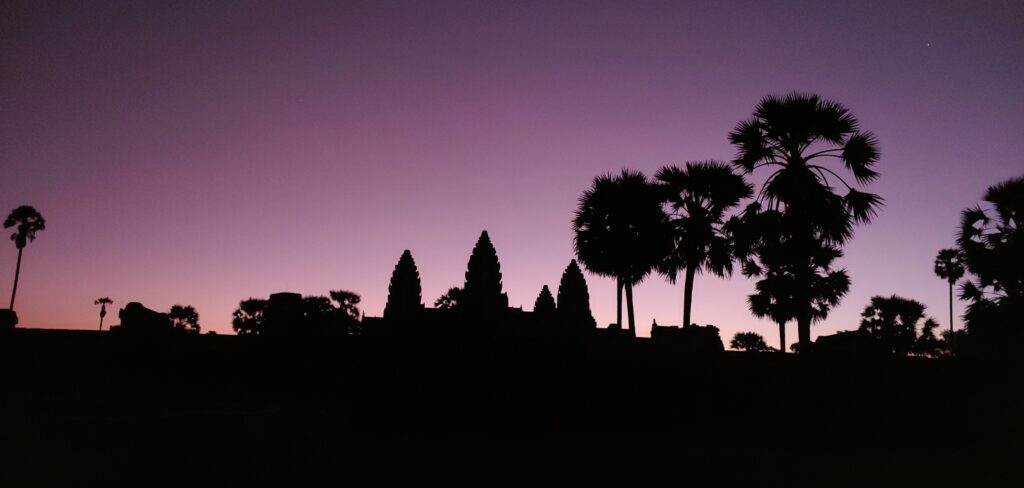
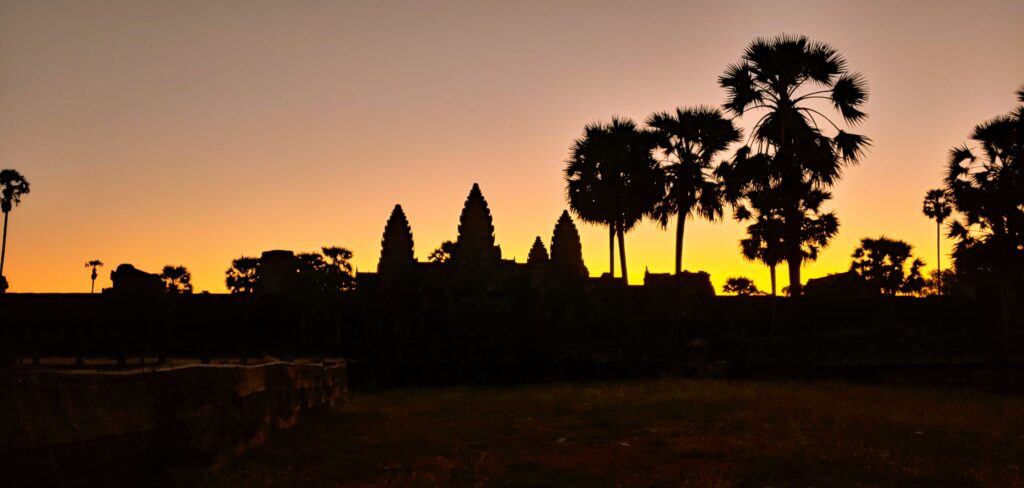
As we are waiting for the temple to open at 05:00, we look up and see the best stars we have seen in all of Southeast Asia. We walked the causeway and went out to a spot Brad was certain was the best angle to see the sun rise. It was so still and dark and all you could hear was the chirping and vibrations of the wildlife singing all around us. We watched the bats and swallows swoop down and around us to get a quick bite before dawn. The sky slowly changed from a deep black purple into the warmest yellow gold. The silhouette of the temple was iconic and I felt like I was in a dream. No one was around. Just me and my darling in a courtyard in front of one of the most impressive and wondrous sites in the world. Bradley, who I always joke is my tour guide, reads to me from Lonely Planet all I need to know of this incredible place, the symbolism in every single part, as well as his memories and recollections from his previous visits. Bradley said he had never been when the sky was so clear and you could actually see the sunrise. That there would be tourists shoulder to shoulder to get the best camera shots and stampedes of Chinese tourists traveling by the busload. I was incredibly grateful for our current experience. I understood that hardly anyone in the world would ever see this place the way I was getting to see it.
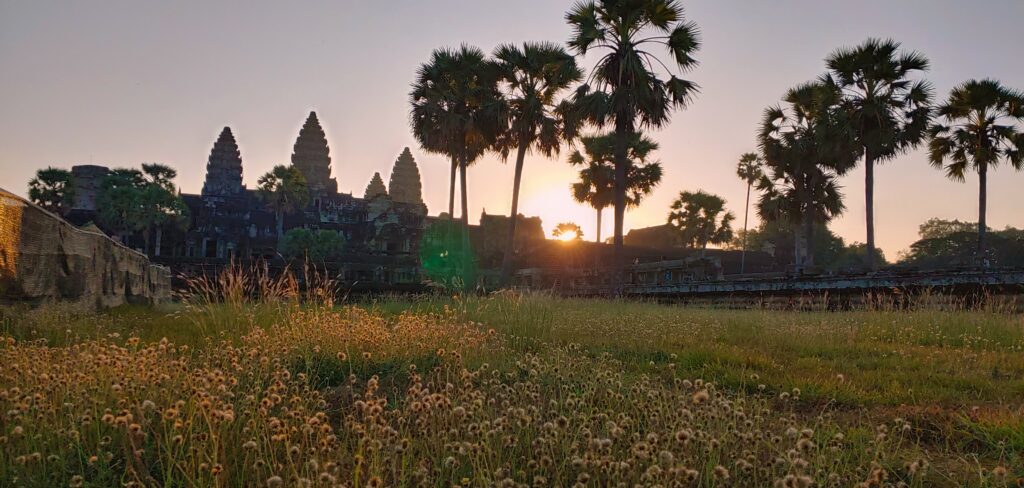
We took our sweet time walking through the temple. Bradley said he always felt rushed in previous visits with people very close to him generating a kind of hurried crowd flow. That day we ran into a couple folks every now and then, but most times we were all alone. I am speechless as we proceed through the hallways and for each new room we enter. The size of the place! The level of detail and dedication each section of stone required. The impeccable straight lines and resounding architecture. I try to imagine what this place looked like centuries ago, covered in bright colors with monks in sacred orange walking around with peaceful faces.
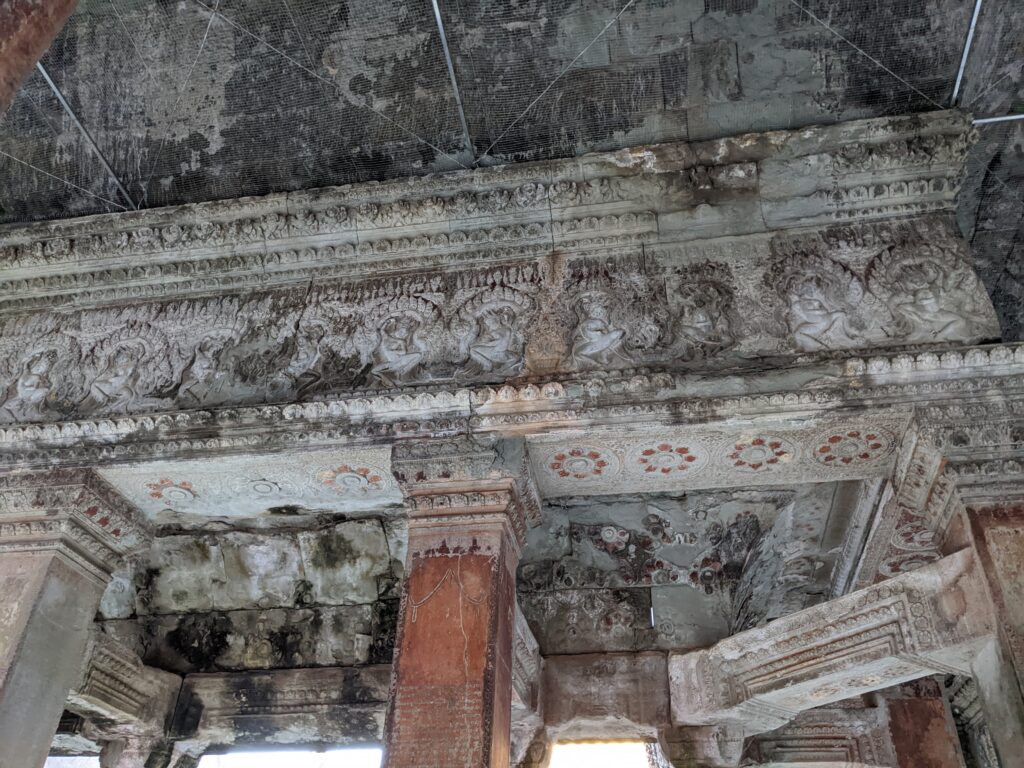
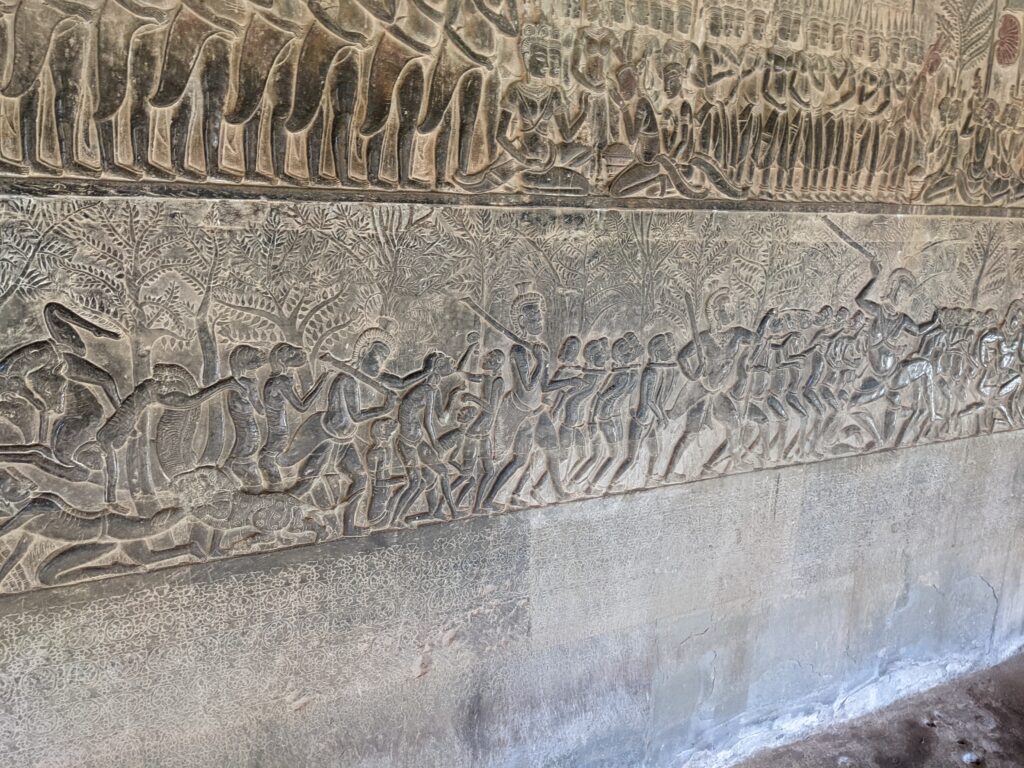
There are 8 galleries of bas-reliefs, 2 on each side of the temple. A bas-relief is a massive carved picture depicting a story or tale. Bradley would read to me what each one represented and we would find all the special points of reference from the book. My heart sinks as I see graffiti and desecration on the walls throughout Angkor Wat. It’s unfathomable to me why someone would carve anything onto this place. I saw a lot of words and phrases in other languages. Names of tourists that felt the need to stamp the stone. I was disappointed in my fellow humans.
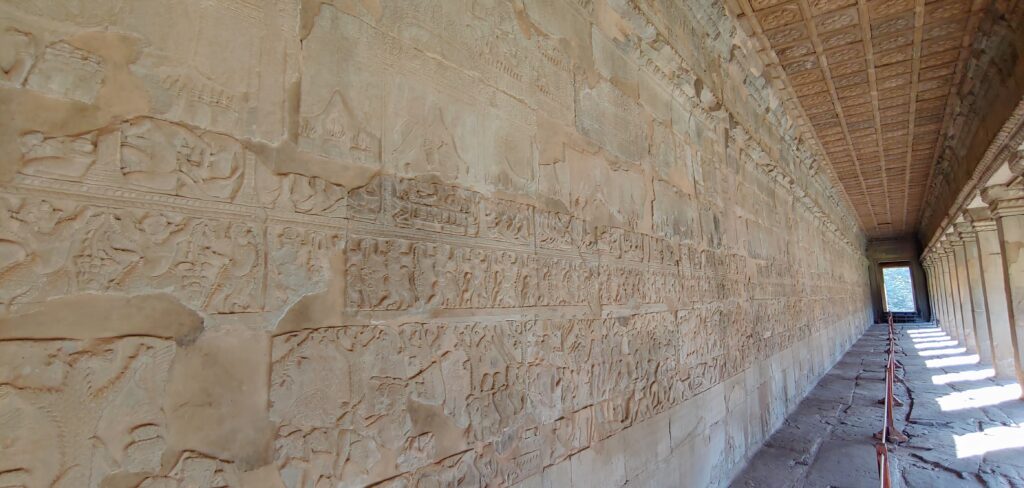
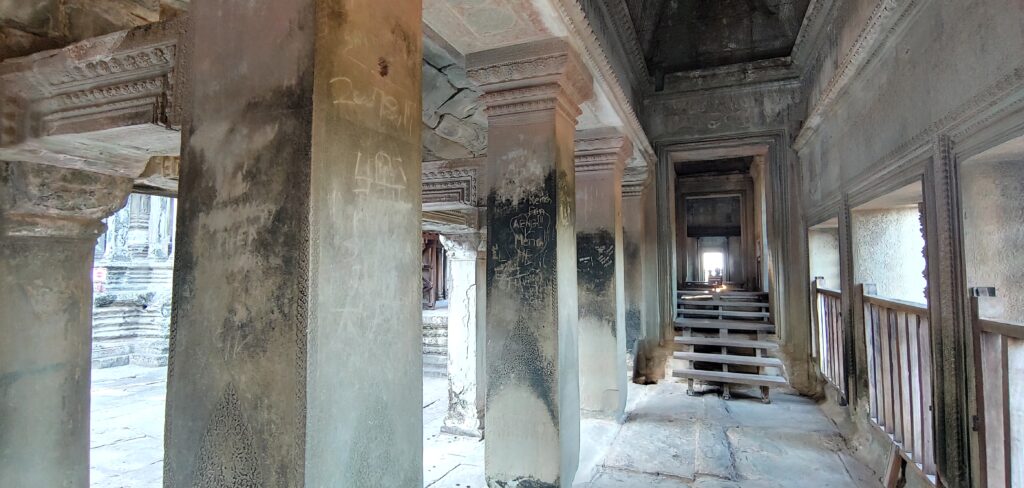
Angkor Wat is quite large and it seems to get bigger the more you explore! It took us roughly 3 hours to walk through and climb up to the higher levels and see everything. There really are no words good enough to describe this temple and do it justice. It is a place that every person must see and experience at least once in their lifetime. If you have never been, I encourage you to start planning your trip! There was quite a bit of conservation work being done to the temple and it was good to see they were making the most of the recent quiet months. It had been a long day already and we needed to refuel before continuing. We stopped and had a bite at one of the many local food stands aggressively calling to us for business just on the side of the temple. It was very confusing and overstimulating hearing all these Khmer women nearly screaming at you to come to their stand. I couldn’t think straight and I did not like it after the zen and peaceful mood the temple had put me in. It was overpriced and everything was the same price no matter what you ordered. A typical Southeast Asian pricing structure! It was a decent meal though and gave us more energy. After a 15 minute walk back to our driver we were on to visit Bayon!
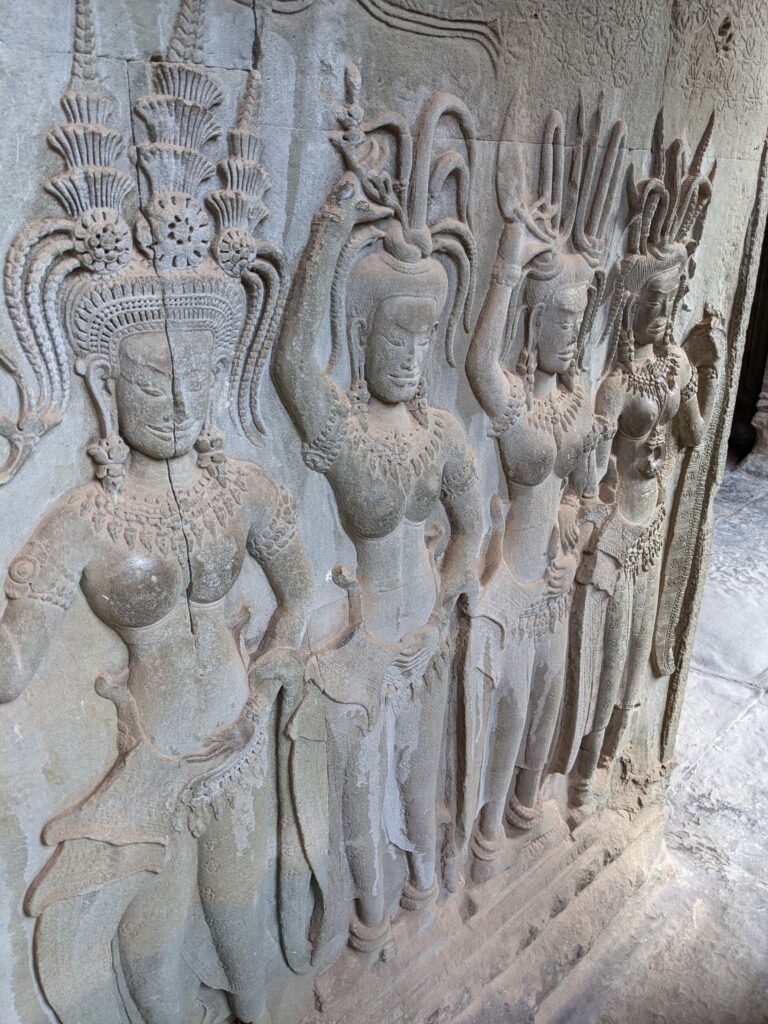
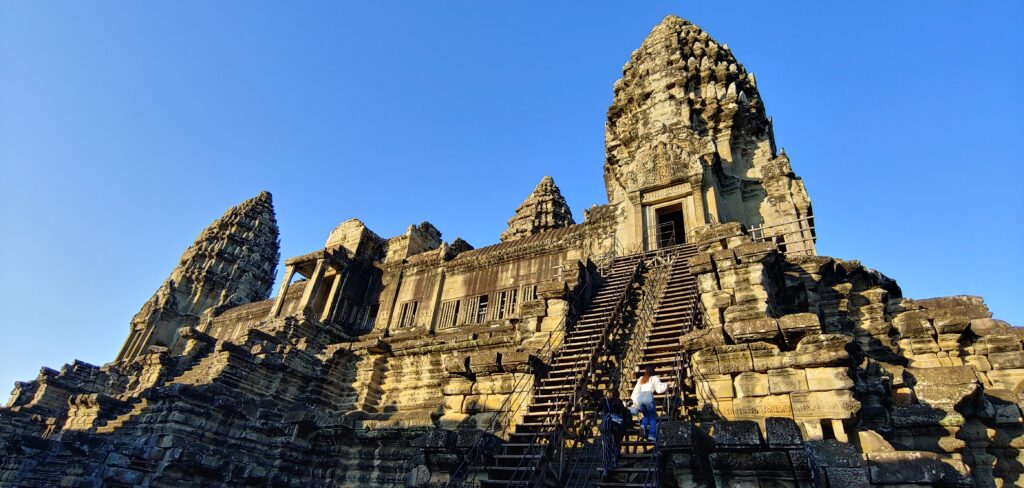
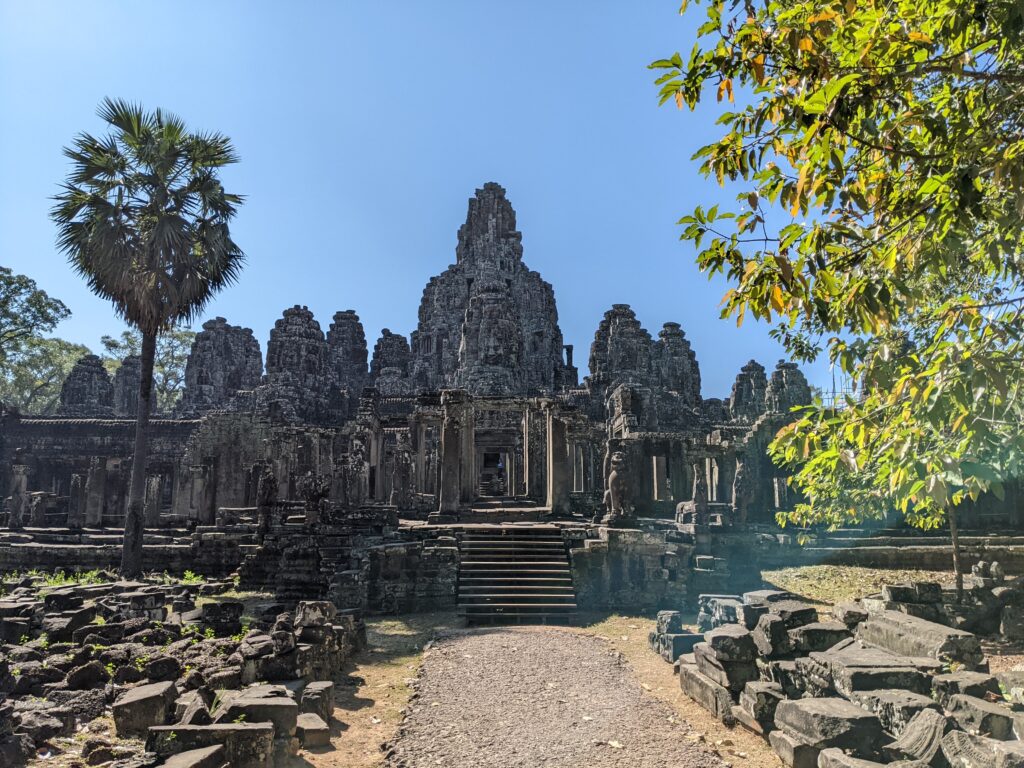
Bayon was built in the late 12th and early 13th century and I truly enjoyed visiting this temple. The iconic feature of this temple are the 4 faces of what is suspected to be the King Jayavarman VII on each tower. Each tower has 4 faces that point in each cardinal direction, looking serene and stoic. The images of these faces represent Cambodia almost as much as the great Angkor Wat. It is surrounded by beautiful jungle and the rubble from its own deteriorating structures. This temple also has 2 bas-reliefs on each side depicting incredibly preserved images. Some are of crocodiles eating men, images of war, soldiers traveling by ship, and giant elephants. Inside, the grounds expand much more than you could see from the outside walls. It is intimidating. I stare at the stones and imagine the weight. And I think about the heat. As you venture farther into the temple it is like a maze. It is full of tight spaces, corridors, and carvings. It is dark and quiet in some places and all you can hear is the jungle. The floor plan doesn’t make sense to me and seems really impractical for any real use but even still it is something to behold. I felt like an explorer discovering something ancient for the first time. When I was a kid I went through a period of time where I wanted to be an archeologist. It really brought out the little Kayla in me.
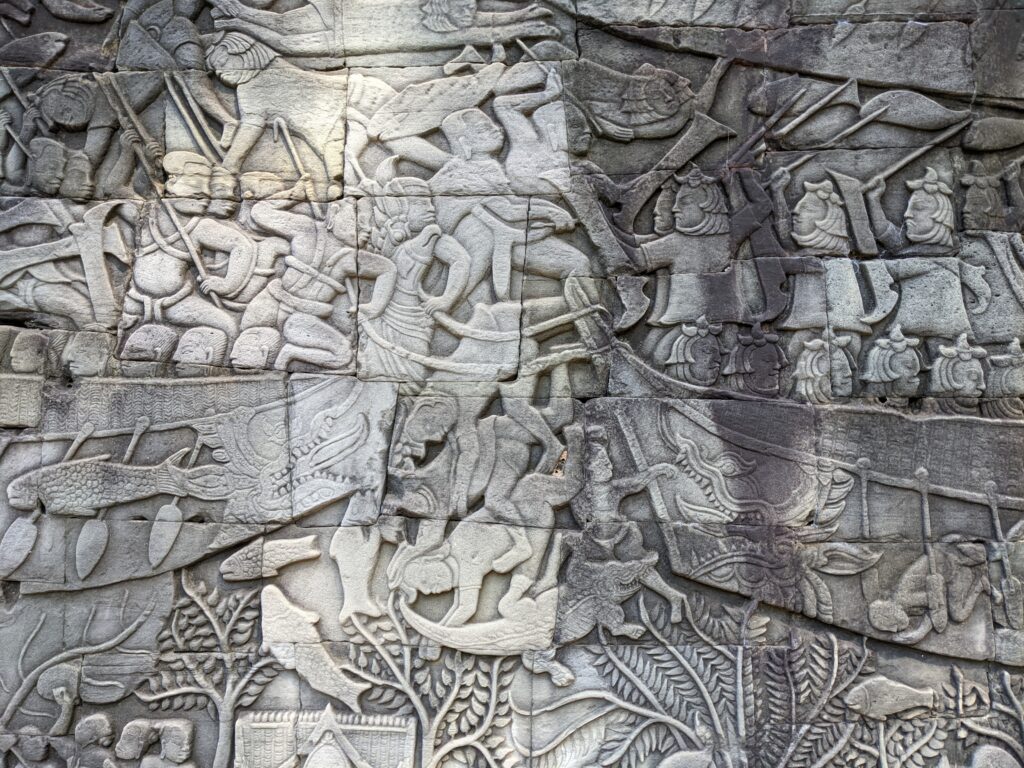
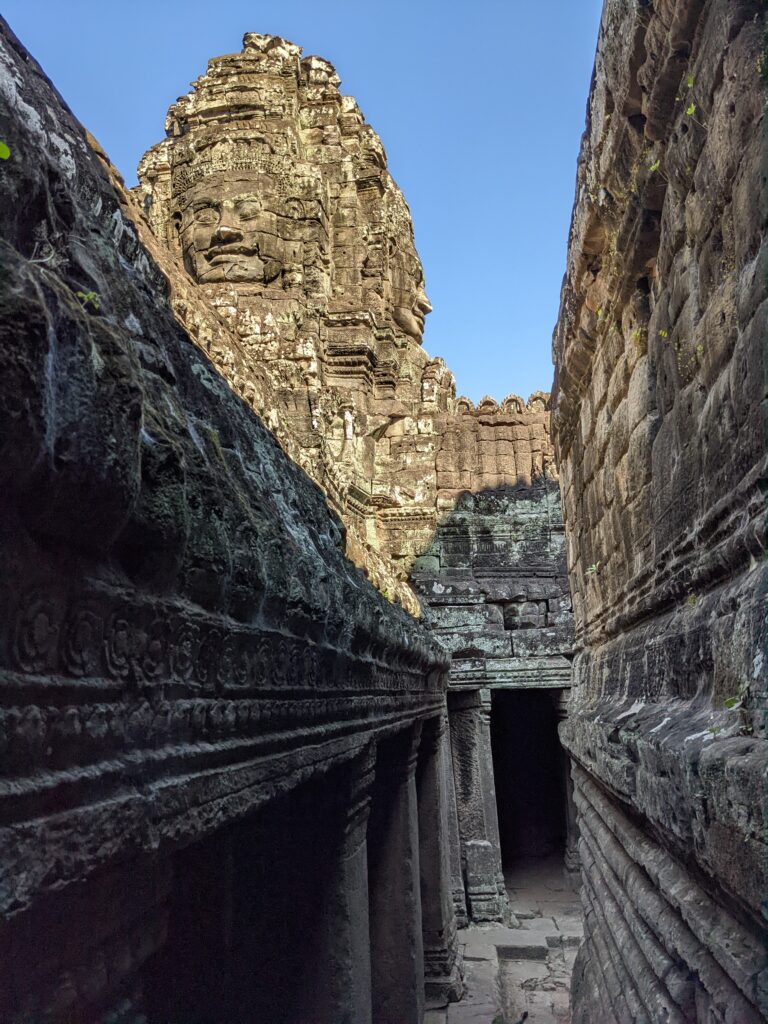
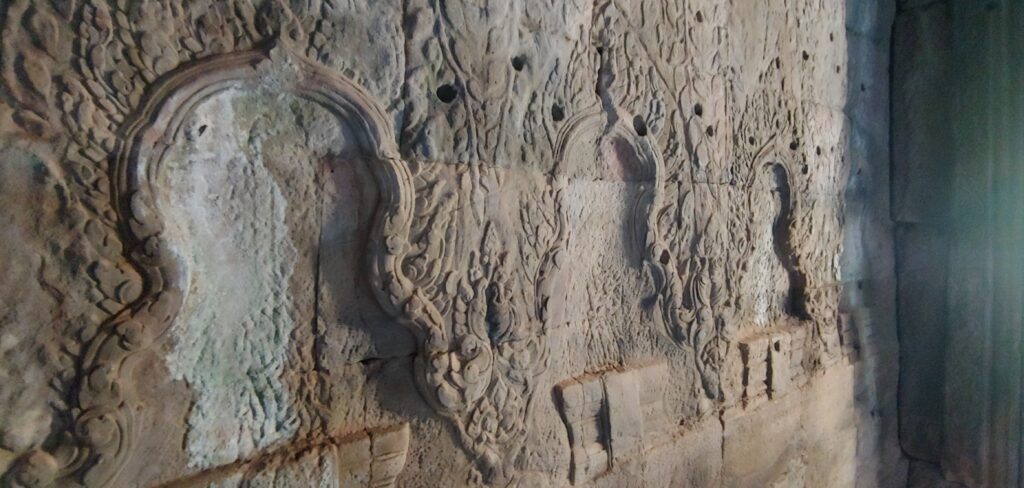
The next several temples and ruins were all incredible and breathtaking in their own special ways. We visited Baphuon Temple which had a dramatically long causeway with ancient ponds on each side. The doors of the temple were so small that even I had to duck down to explore! It was full of lots of steep steps.
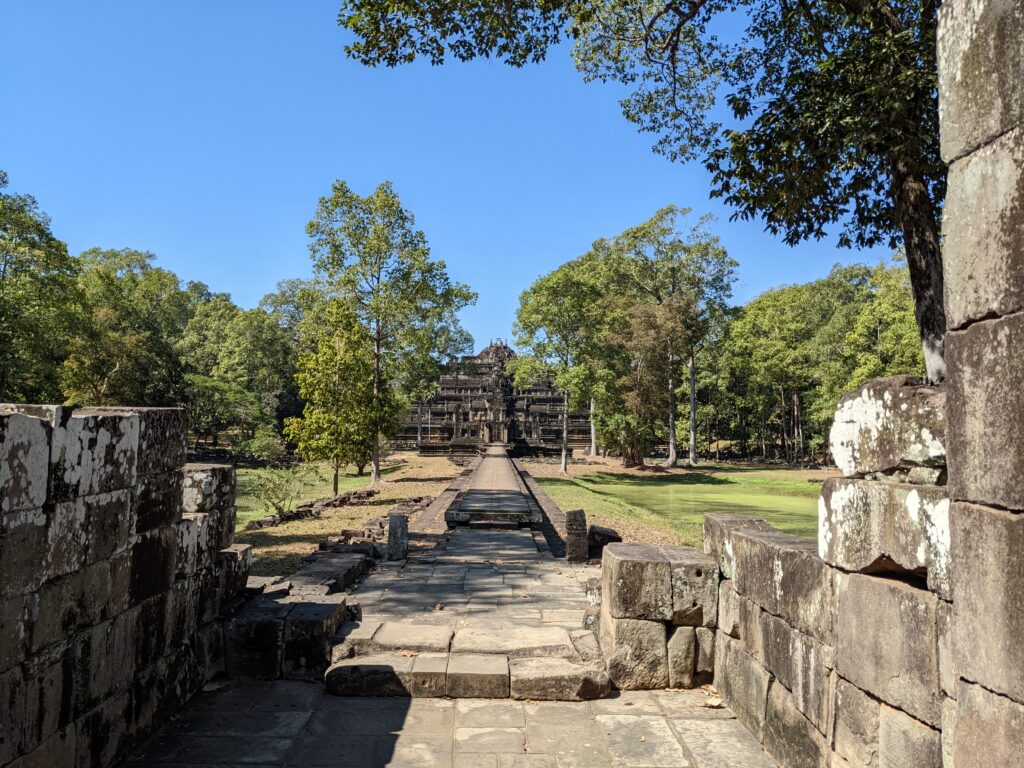
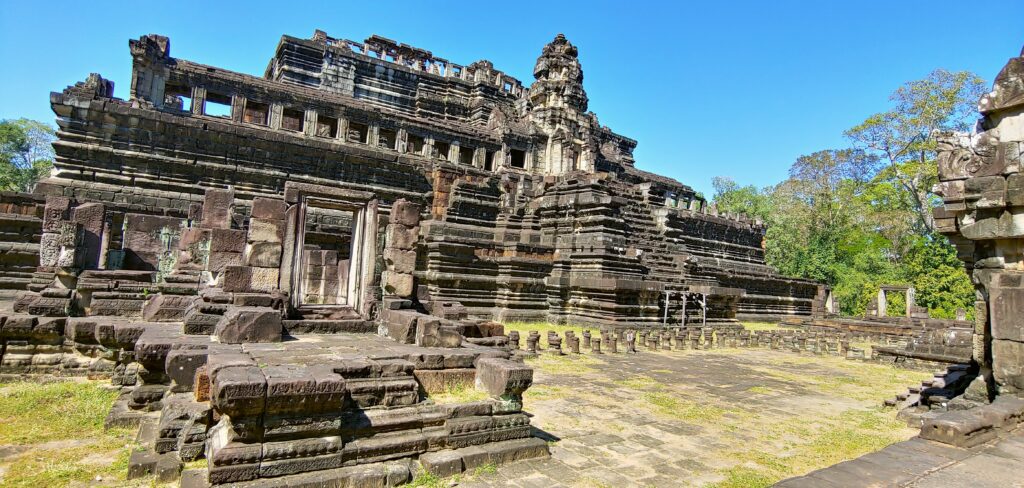
From there we walked through the jungle forest to the Terrace of the Elephants, where the ancient Khmer kings addressed their people, and the Terrace of the Leper King neighboring side by side. The Terrace of the Leper King was brilliant in artisanship and had maze-like trench walls of detailed Yaksas and Yakshinis from the underworld carved in sandstone.
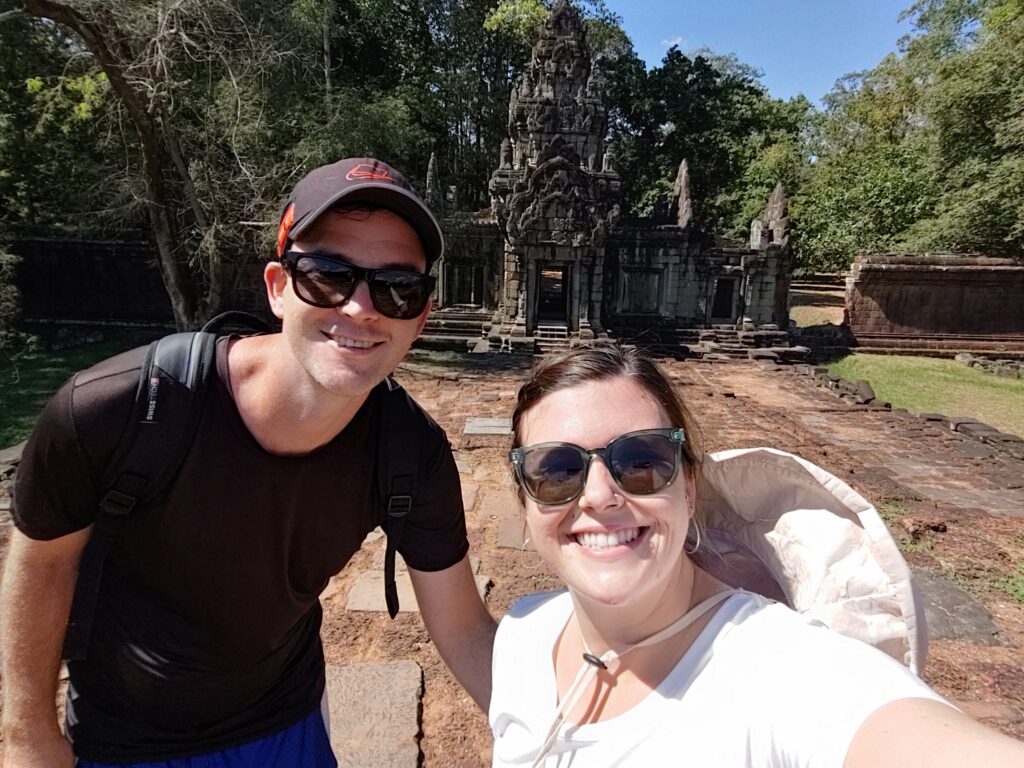
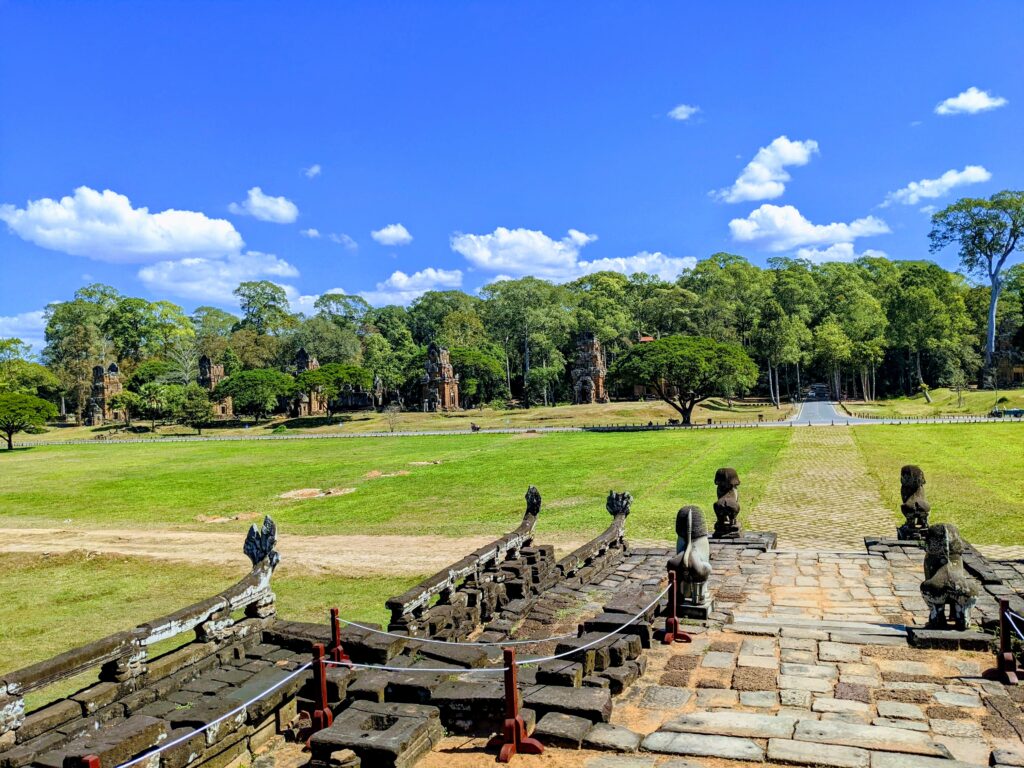
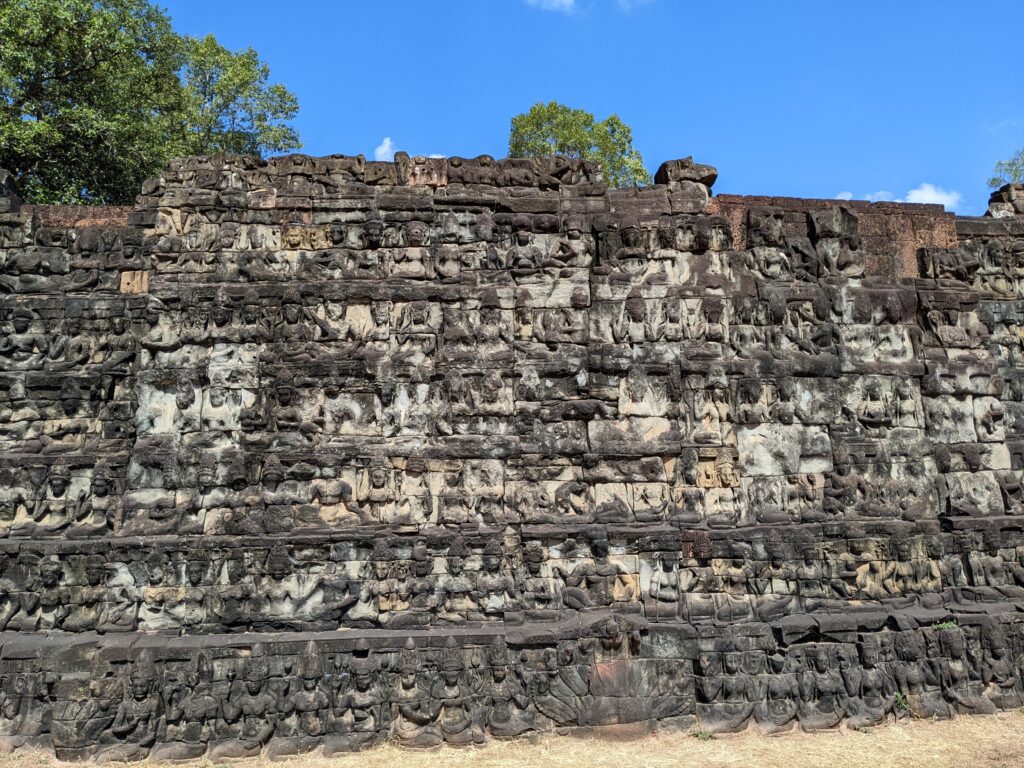
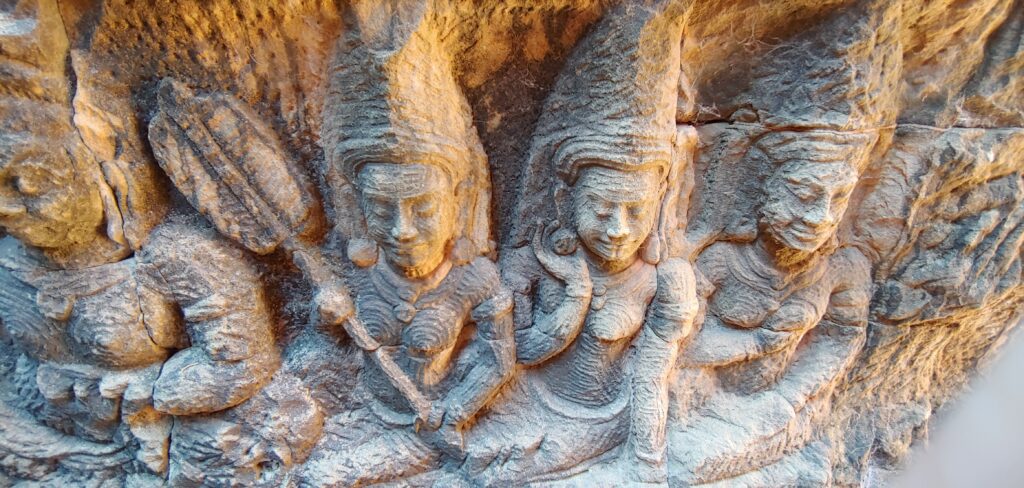
Thommanon and Chau Say Tevoda temples were next after leaving the walls of Angkor Thom and passing through Victory Gate. When we were stopped, the only other people there were taking professional wedding photos. It is very popular in Khmer culture to take wedding photos clad in traditional dress in front of temples for good luck and blessings in their marriage. We saw this a lot throughout our time in Cambodia. Khmer people really go all out for their weddings. It usually lasts for a day and the traditional music of plheng kar is blasted throughout the neighborhood.
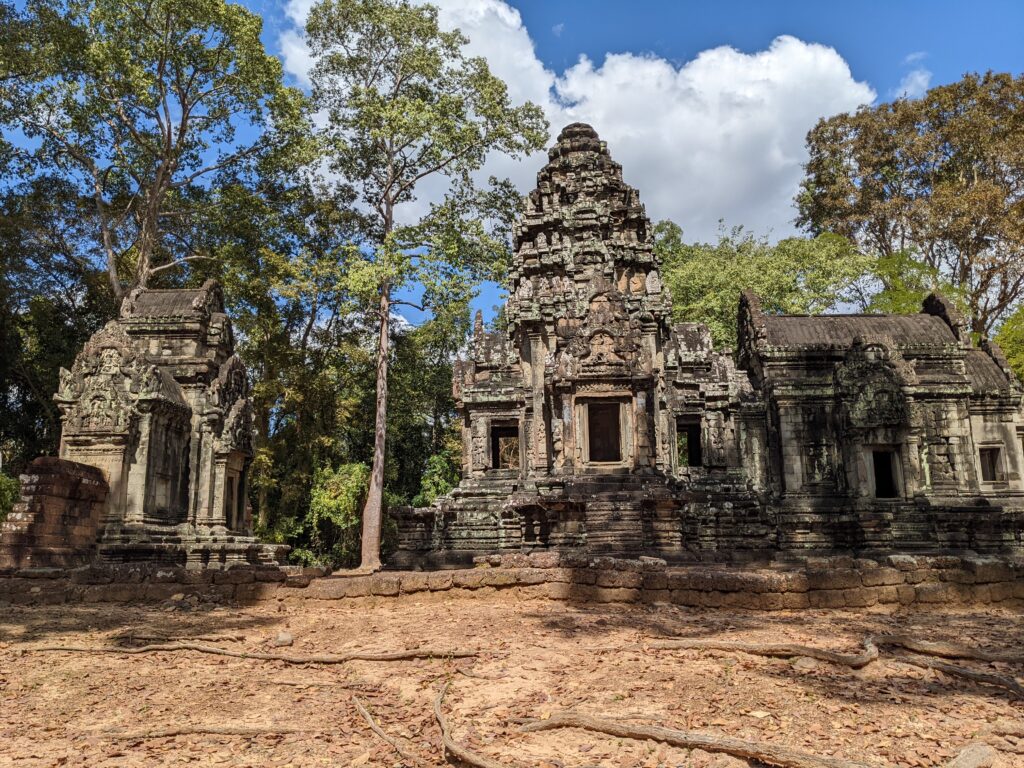
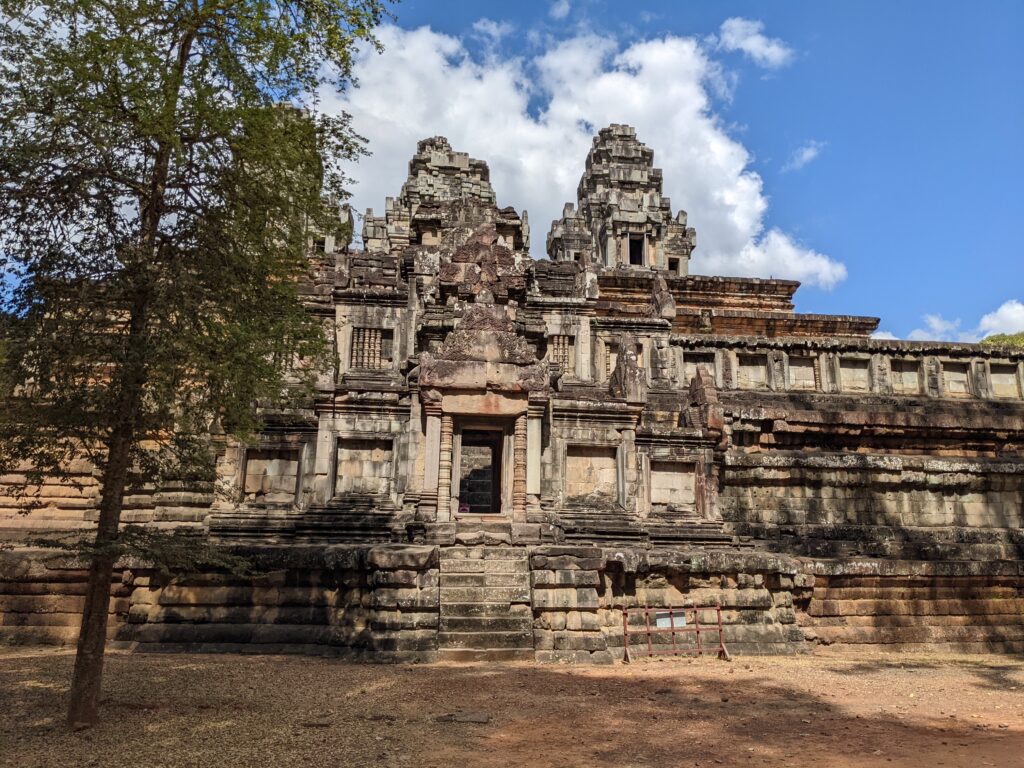
The last, but most certainly not least, temple of the day was Ta Prohm. And it was my absolute favorite! Surrounded by dense jungle, it was built in the late 12th century and was originally called Rajavihara. It is covered in the seafoam moss and fungus that give it a wild and abandoned look. The most striking characteristic of this temple are the romantic and ensnaring roots of the various fig, banyon, and kapok trees. Ta Prohm and the jungle are one. For many reasons, it is one of the most famous temples in the world. As a kid I didn’t really play video games..but I played Tomb Raider. And I wanted to be Lara Croft. She was a hero for me just like every other young girl who wanted to discover and dig up ancient things for a living. I also wanted to be a badass and explore the world. The movie Tomb Raider starring Angelina Jolie as Lara Croft came out in 2001 and I was obviously obsessed. It was filmed in Cambodia with several scenes shot at the alluring Ta Prohm. Since the movie was released, Ta Prohm’s popularity has grown significantly and is usually overcrowded with tourists. I felt so special to have it all to myself. I felt like Lara freaking Croft! A real raider! We walked and climbed around for about two hours. It is a big place and I wanted to take in everything. The songs of jungle birds filled the air. The insects hummed along. It smelled spicy like decaying leaves and bark, fresh like wet grass, and musky like bat guano. The colossal trees and tribute to nature’s strength and patience over time humbled me. I’m filled with the hope that life always finds a way. It was such a magical experience for me.
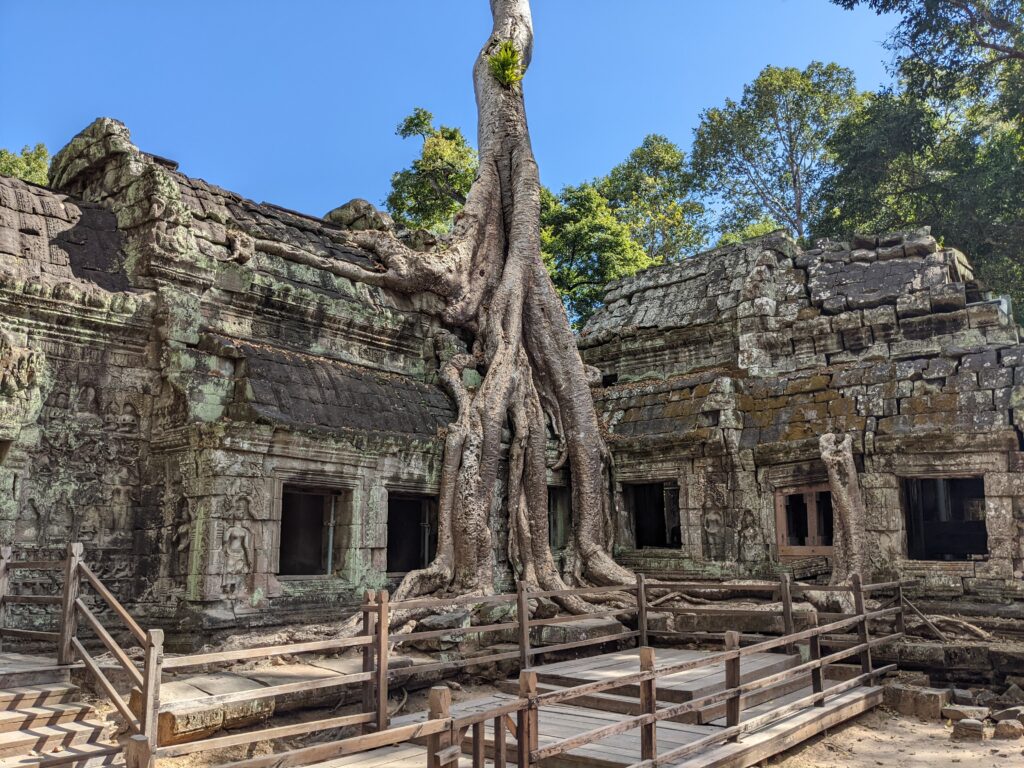
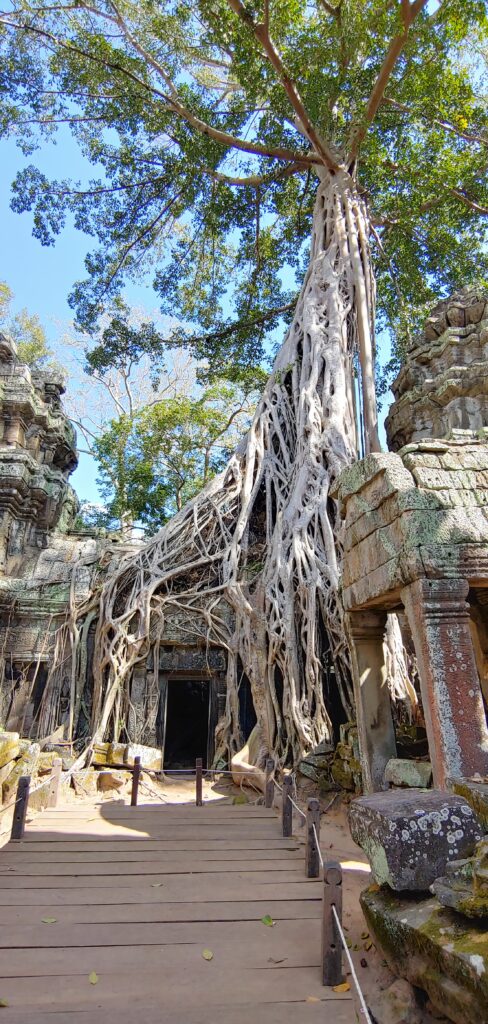
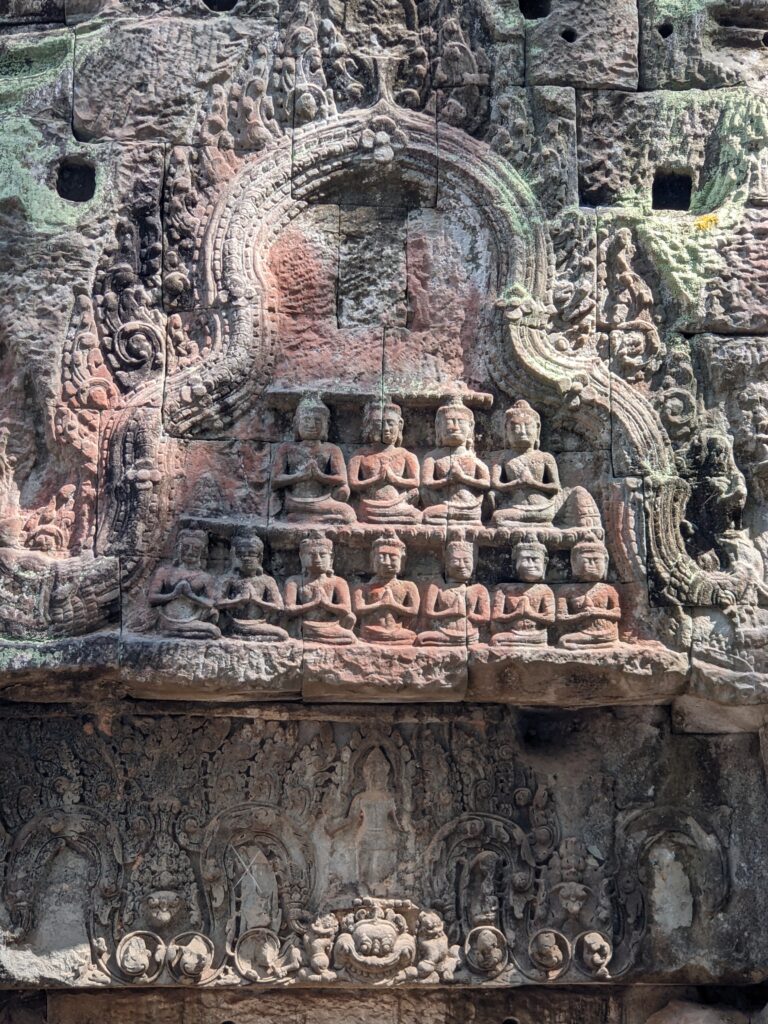
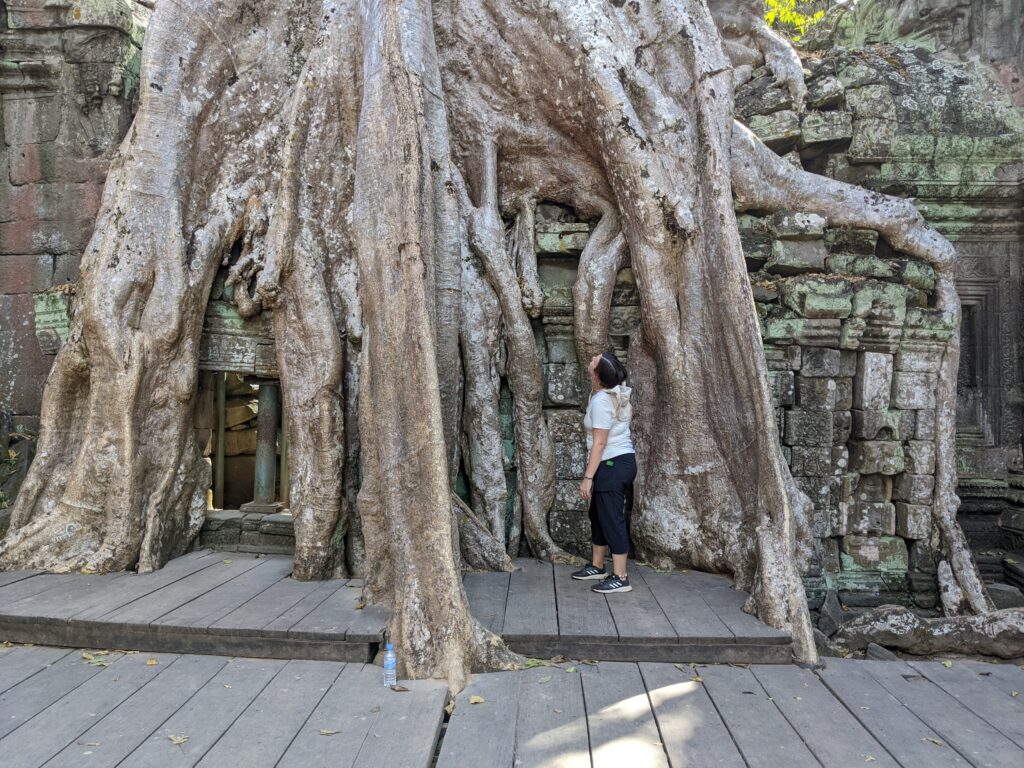
Day Two:
Our second day of adventure started with the temple of Preah Khan, meaning Royal Sword. I really liked this temple! It was built to be a Buddhist academy and a city. It had a regal and elaborate causeway lined with naga snakes and a moat surrounding the grounds. It spans about 140 acres and took us over an hour to explore. It was incredibly beautiful with intricate reliefs carved everywhere. There are piles of sandstone and laterite all over exposing the ages. Trees are taking over along walls and towering high into the sky. It made me giddy knowing we were walking the paths of an entire ancient city. Lots of platforms and interior structures and corridors. Even an enigmatic structure with Grecian style columns that still perplexes archeologists and historians. The architecture was awesome!
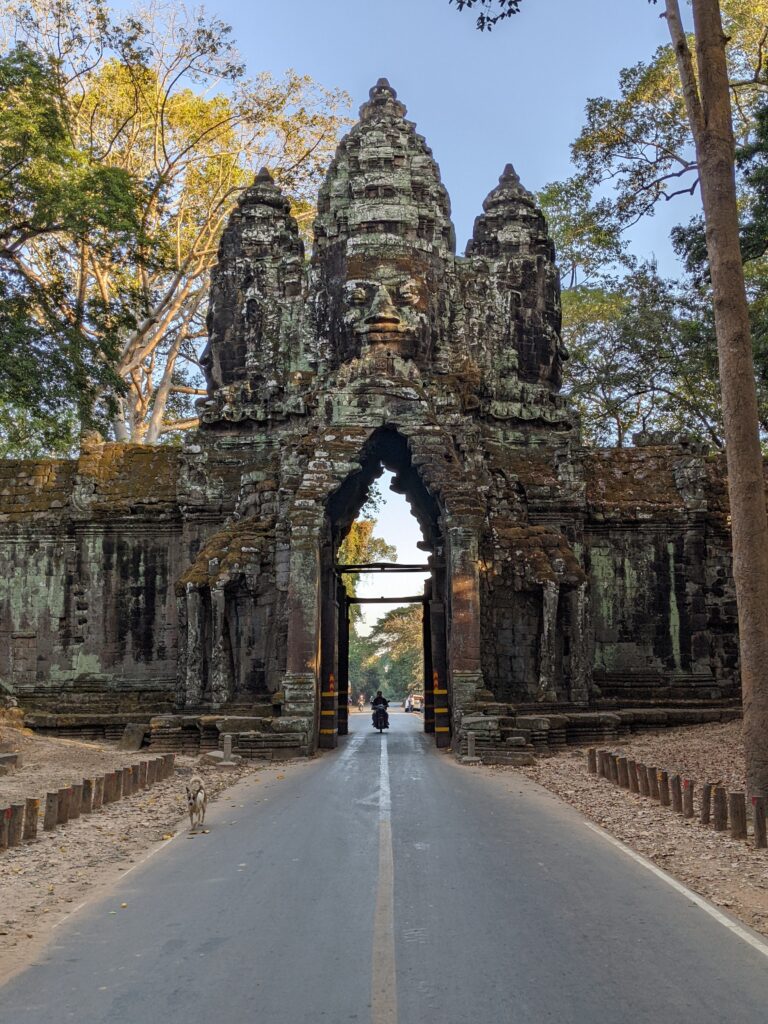
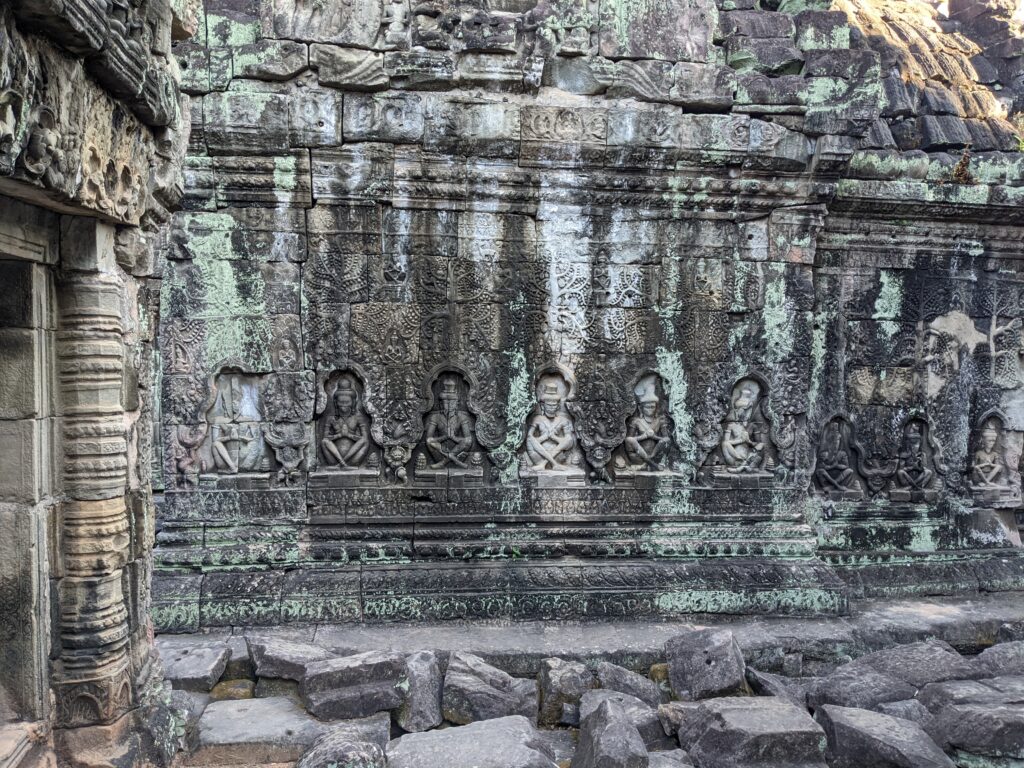
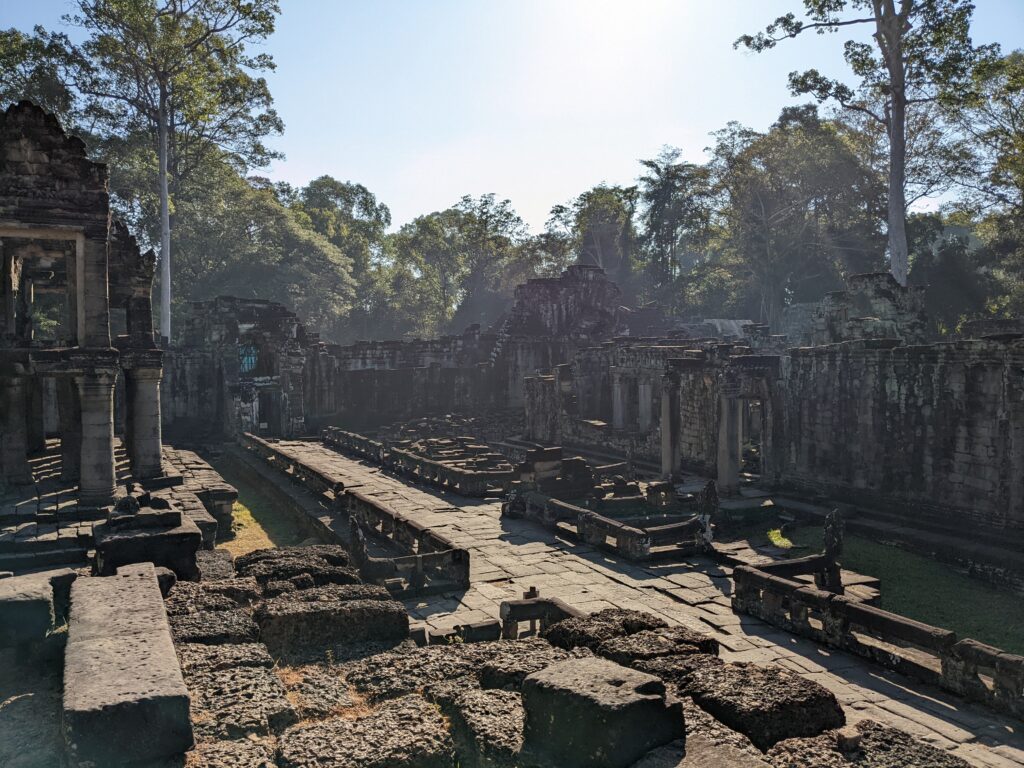
We waded through water on a very rickety and partially submerged metal bridge for about 400 meters to get to Neak Pean. While it was nerve racking, I quite enjoyed taking off my shoes and splashing through the cold water in the middle of the heat. I was successful in keeping out anxious thoughts of the bridge giving way. We waded as quickly as we could and safely made it to the other side! This temple was enchanting and extraordinary with its island-like build and ritual purification pools. It was the most unique temple to me because of these features. The water was so still it was like a mirror tinted green by moss and algae. Wading back the 400 meters was easier the second time!
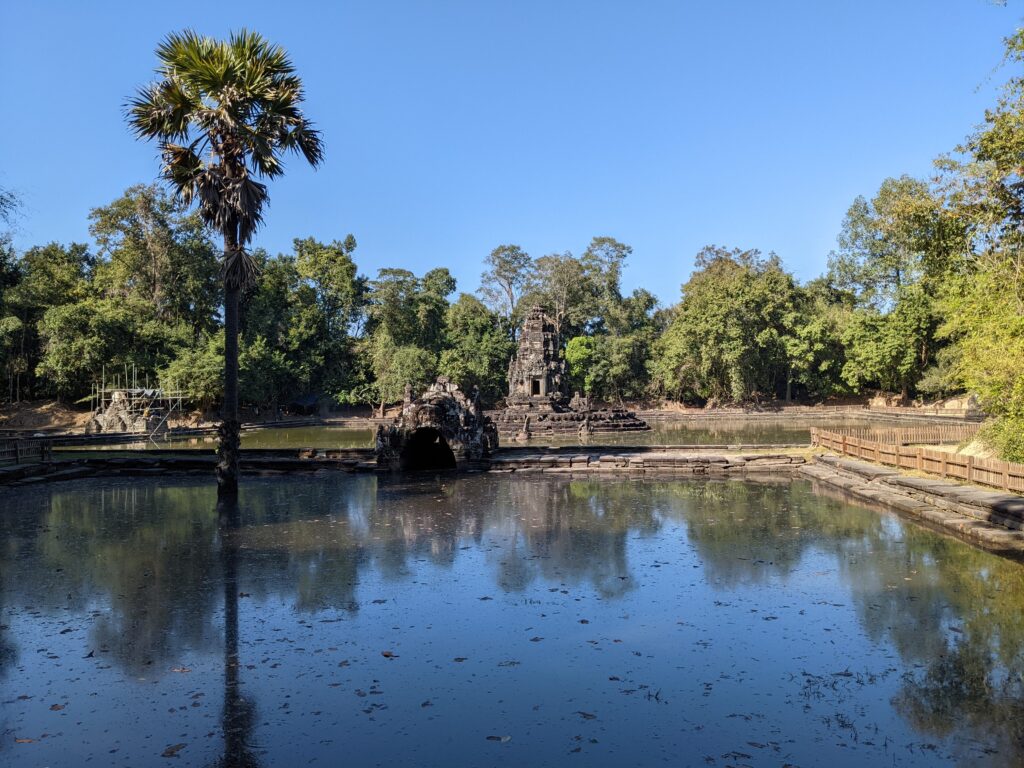
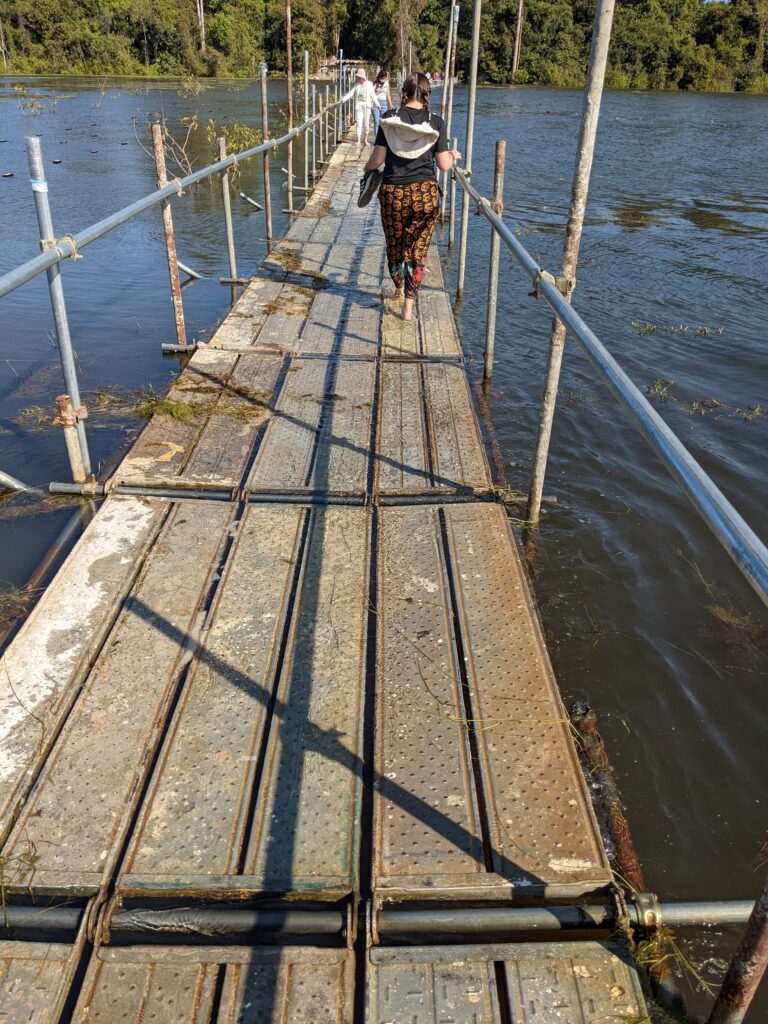
We continued on to Ta Som the purpose of which is still unknown. It has a very famous photo op spot involving, you guessed it…a tree! It is a smaller temple but was beautiful to walk through. There were still many reliefs on the walls that survived the lootings and it was special to see. By the time we got to the east gate where the famous tree that had grown into the temple’s stones is located, we saw that the tree had been cut. Fresh wood shavings and dust still sprinkled the ground and you could smell the tree. It had happened within the last couple days. This had been a brilliant tree that represented the resilience and beauty of nature alongside the creation of man. It was upsetting to see that after all this time they chose to cut it down and claim it as a conservation effort. I had mixed feelings. I understood the need to preserve and conserve a treasured monument in Khmer history, but I also felt that the tree was a part of the magic people come to behold at the ruins in the jungle. Surely the tree had already done the damage. That tree was hundreds of years old. It just didn’t sit right with me.
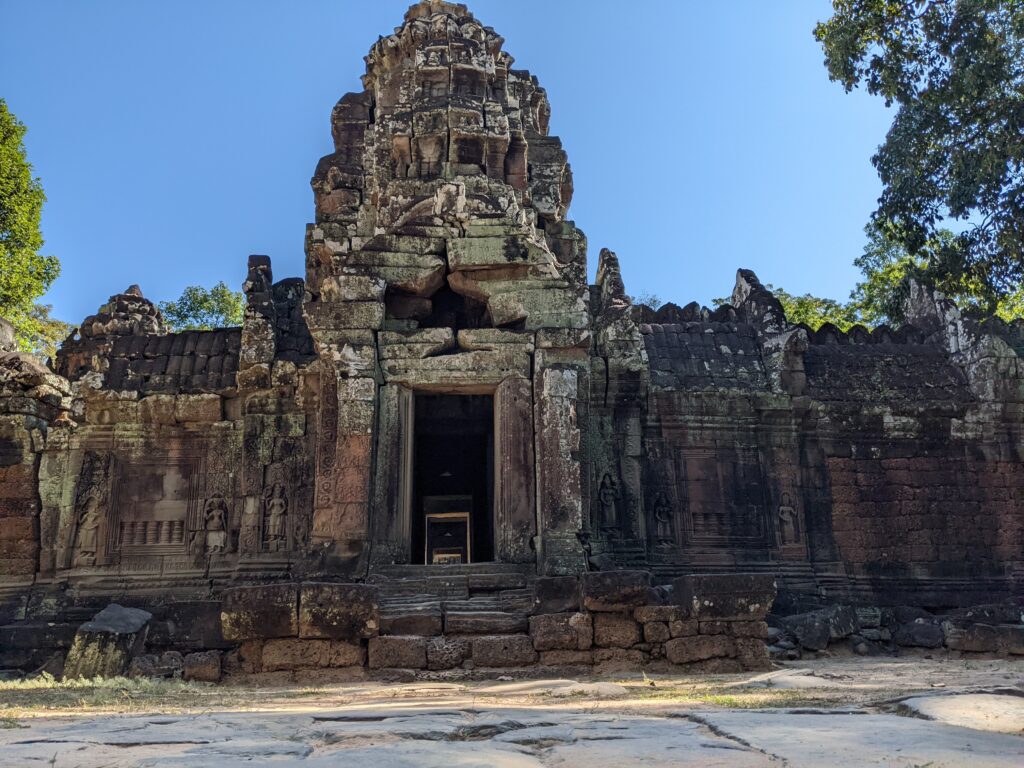
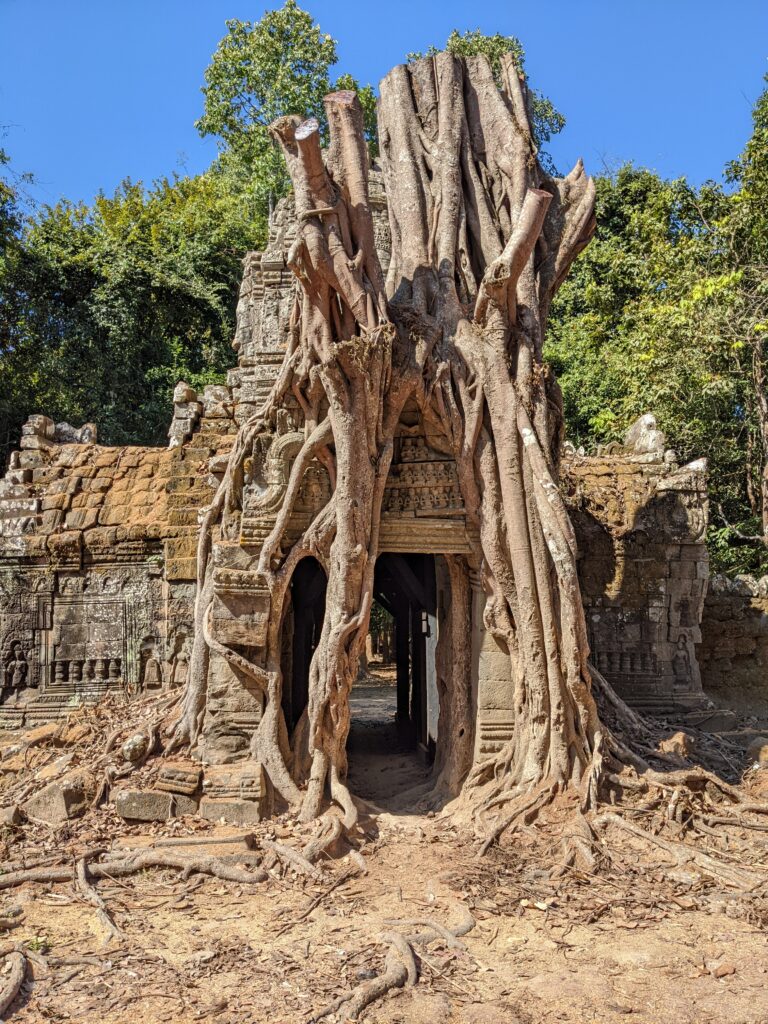
We were feeling spontaneous and after exiting the east gate we decided to take this trail along the wall of Ta Som in the forest instead of cutting straight through the tour path. It was lovely! We swung on vines, saw interesting bugs, heard strange bird songs, and breathed some of the freshest air you can breathe in Cambodia. Always go the road less traveled.
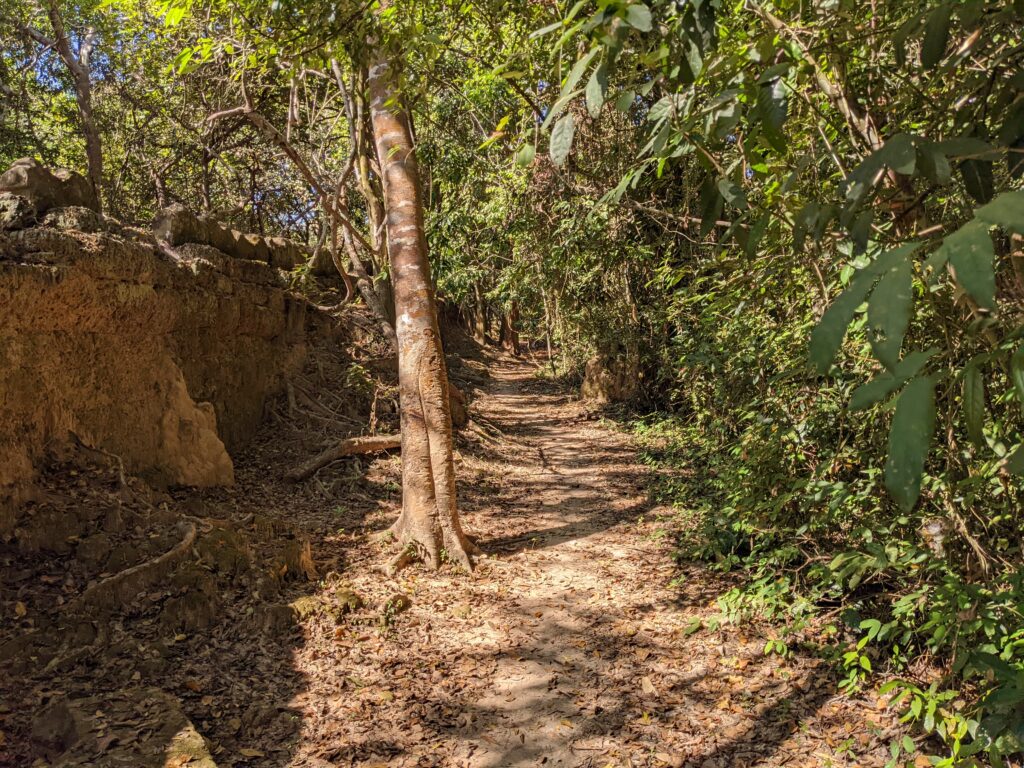
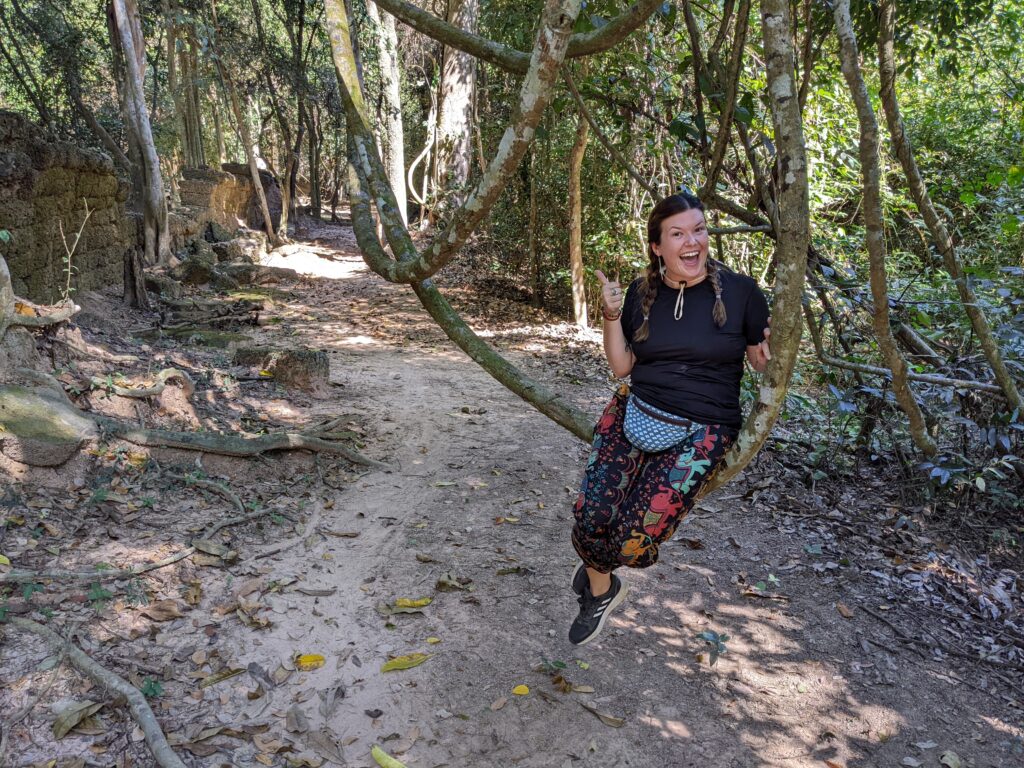
Pre Rup, built in the 10th century, was next. It was full of levels and steps and it was getting hotter! This temple was memorable because of the views and the unbelievable stucco relief that is still intact after all these years exposed to the elements and open air. When you’re in the middle of a temple at the top level looking down you can’t help but imagine the ancient times in the most enchanting way. It may have also been all the endorphins pumping from the climbing!
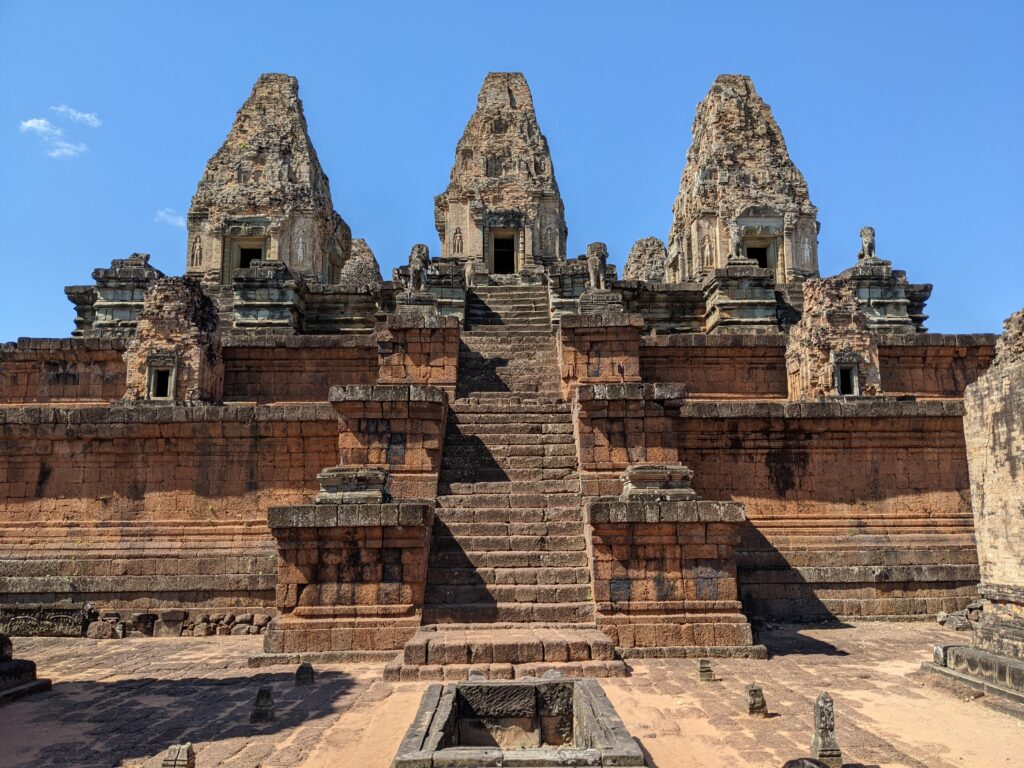
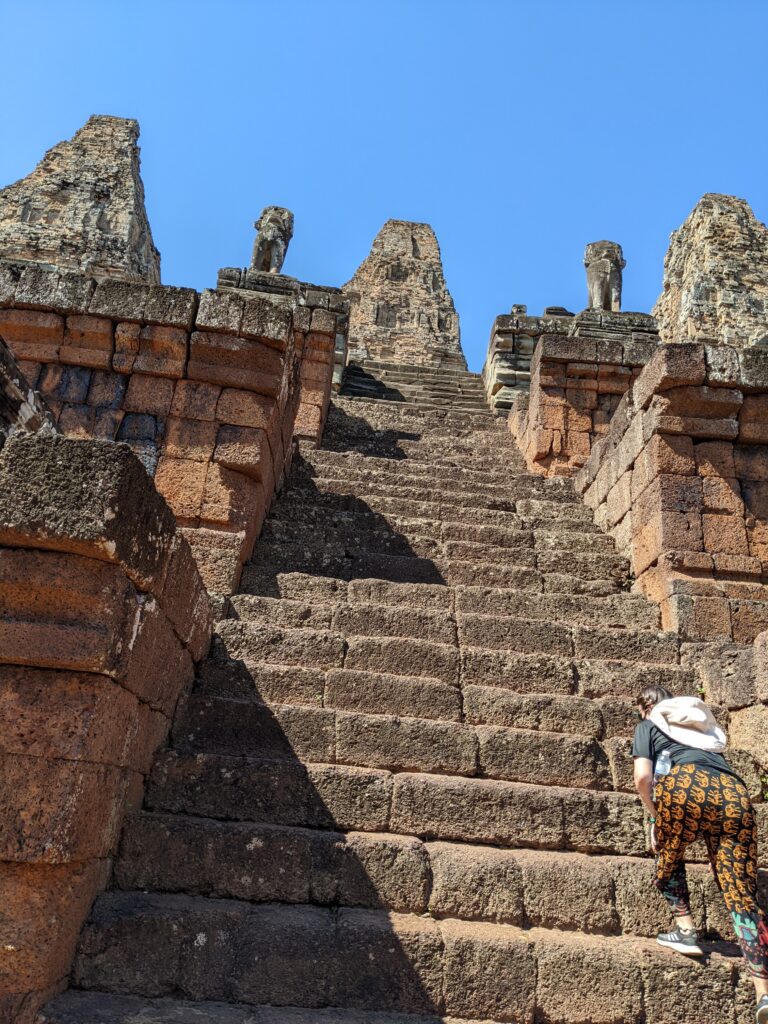
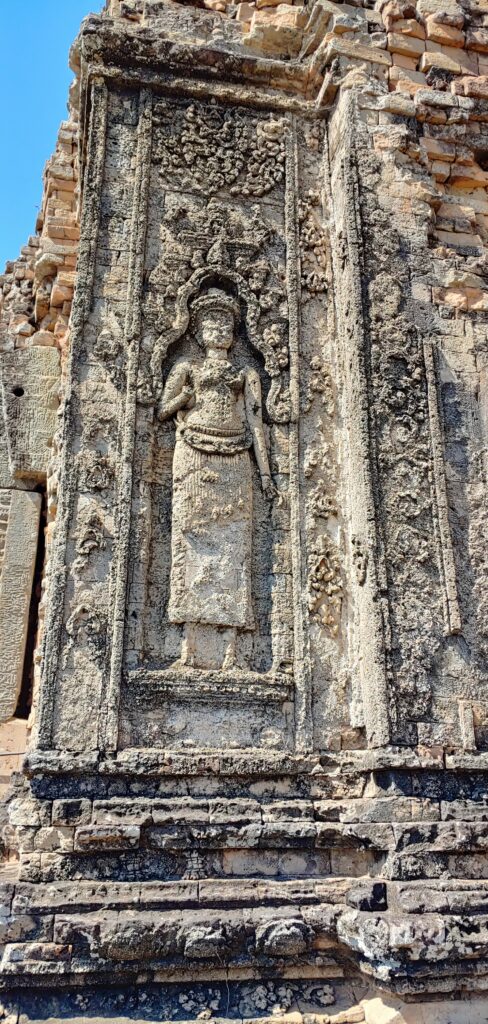
Banteay Kdei was built very quickly in its time, and it showed. It was in the worst condition out of all the temples and falling apart. There was a mesmerizing tree inside the grounds that was the star of the show for me. Srah Srang is just across the way and is fun to say 5 times fast! It is an impressive reservoir that was dug in the mid 10th century. The ancient Khmer were very skilled hydrologists and engineers. All these moats, reservoirs, and lakes were just inspiring to see in person.
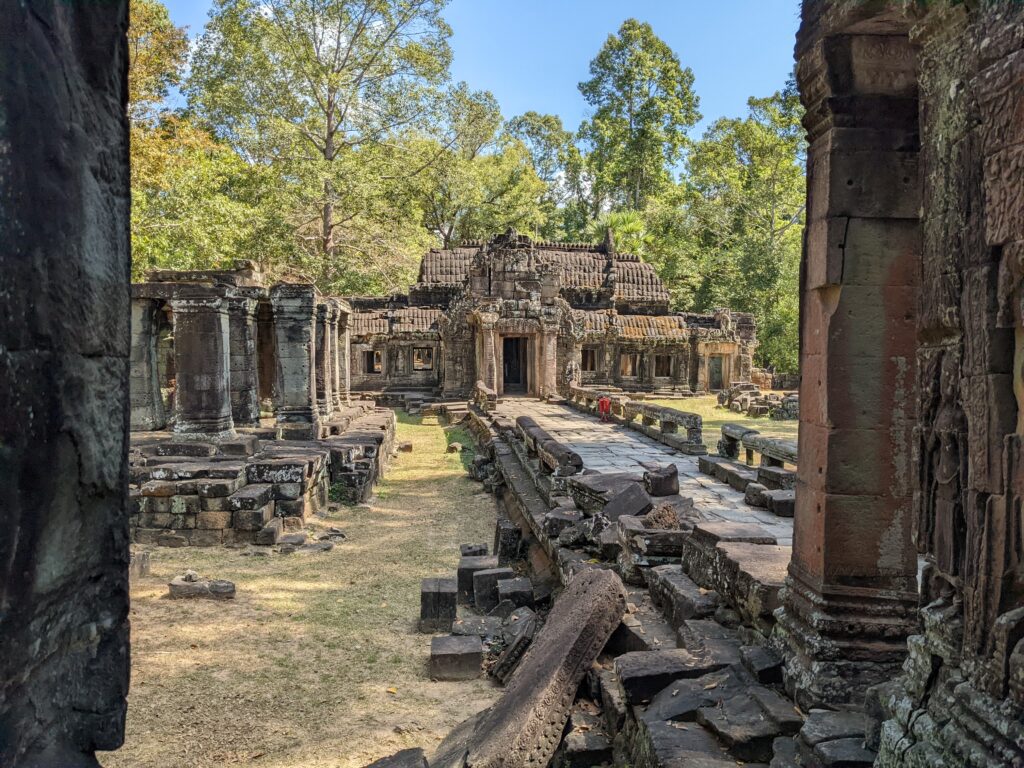
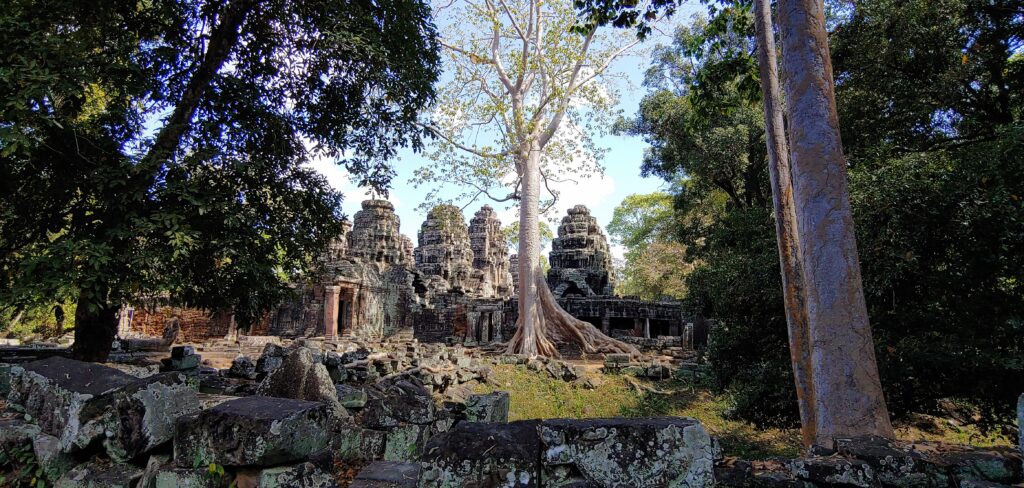
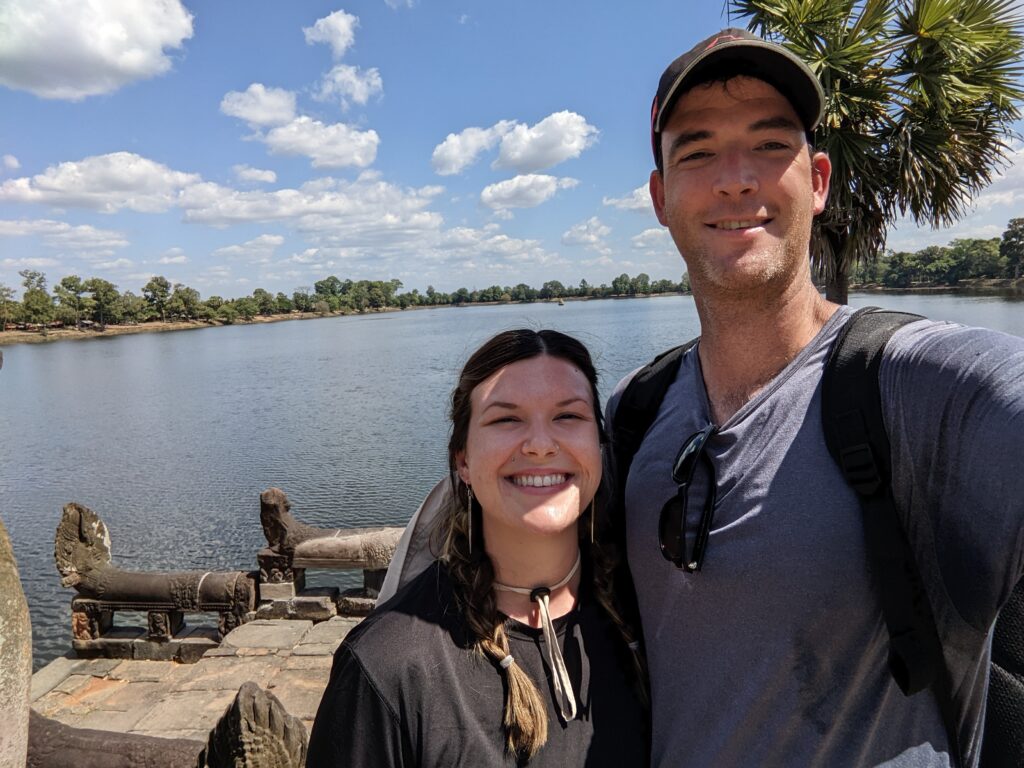
Prasat Kravan was our final stop and we were growing quite tired and soaked by our own sweat. It didn’t hold a candle to any other temple at Angkor in my opinion and what I enjoyed most about visiting this temple were the adorable Khmer children playing in a giant mud puddle. Some were fishing for critters and some were splashing and playing. It was something my sister and I did as kids and it warmed my heart. We ended our day with burgers and cocktails. It was a perfectly exhausting adventure!
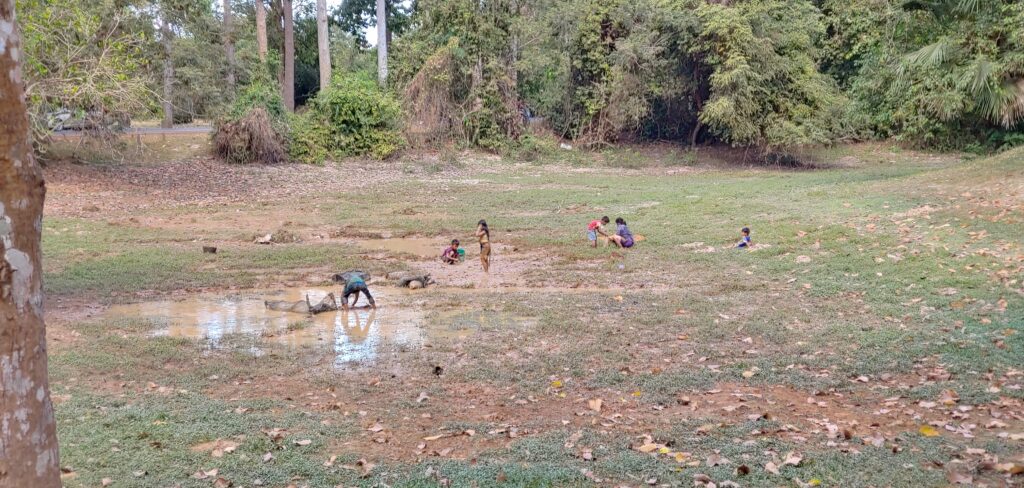
Day Three:
It was finally time to see the other temple I was very excited about visiting, Banteay Srei. It was a 45 minute tuk tuk ride away and I enjoyed every minute! It was bumpy and wild but driving through the countryside of Cambodia in a tuk tuk is one of my favorite ways to see Cambodia. It had even become almost like a meditative time I had grown fond of. It gave me so much tranquility, insight, and joy.
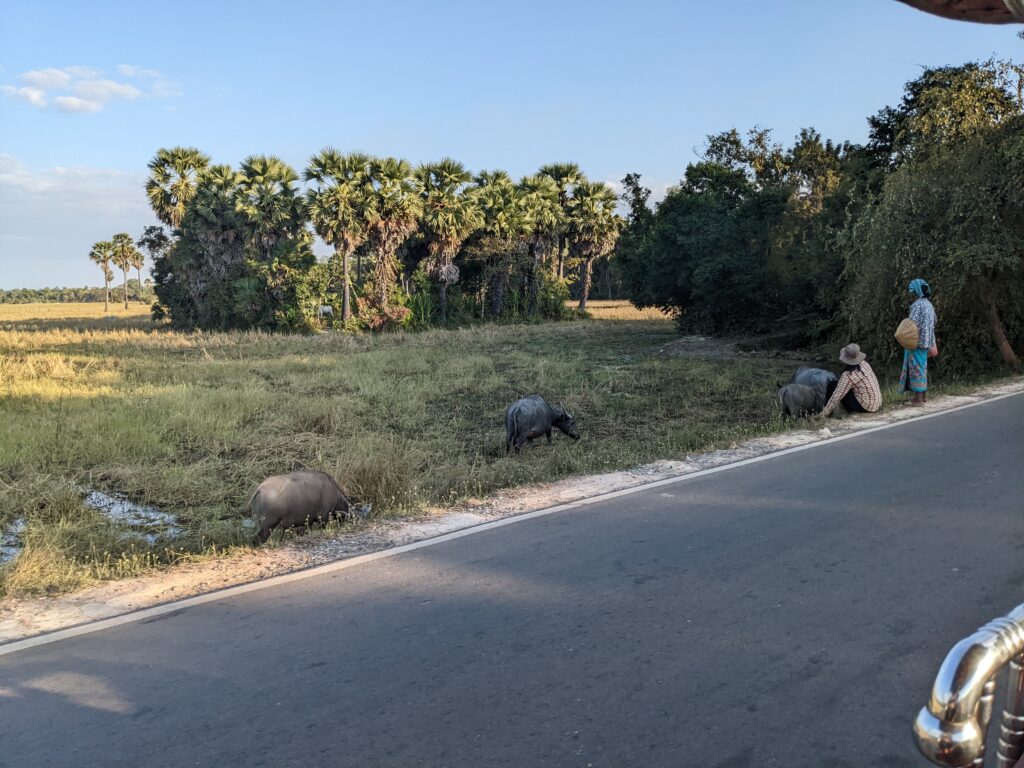
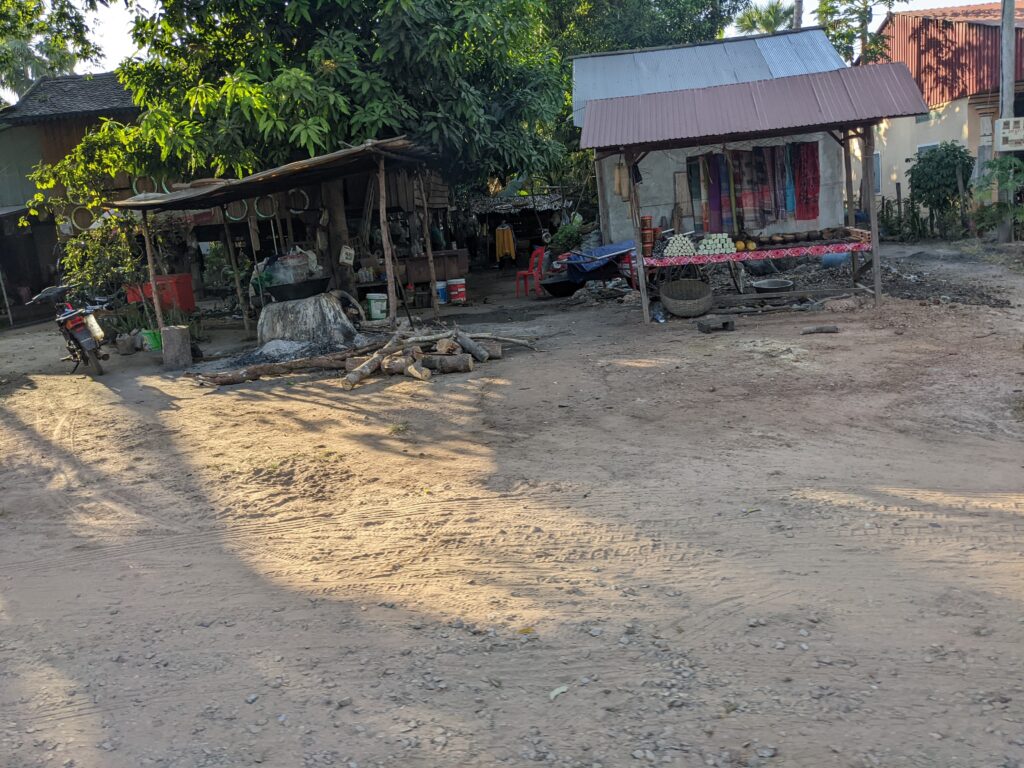
At Banteay Srei I was lured in by the beautiful pink hues in the sandstone. Banteay Srei, built in the 10th century, means Citadel of Women and is dedicated to Shiva. The legend tells that only the hands of a woman could have carved such small and intricate images that cover the temple. I was speechless nearly the entire time. Gasping “wow!” over and over again. No other temples compared in detail or beauty and it moved me. Overwhelmed by the devotion and love that this place represented. The time it took and the great patience and care that was put into each chisel and cut. What a creation that has stood the tests of time!
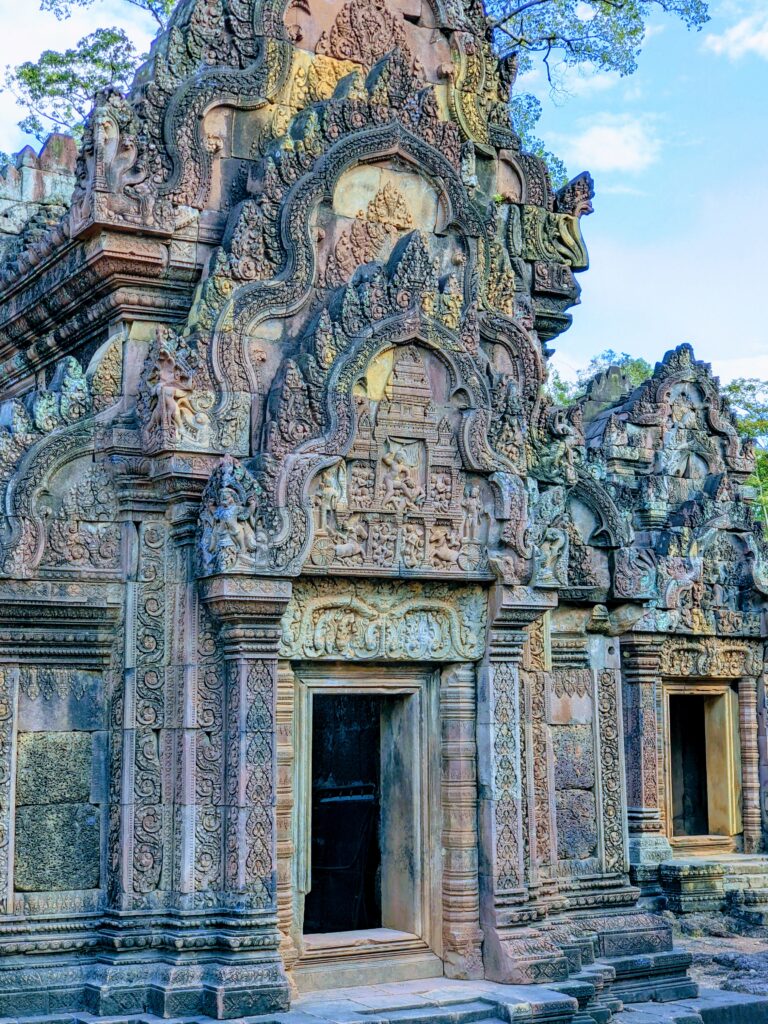
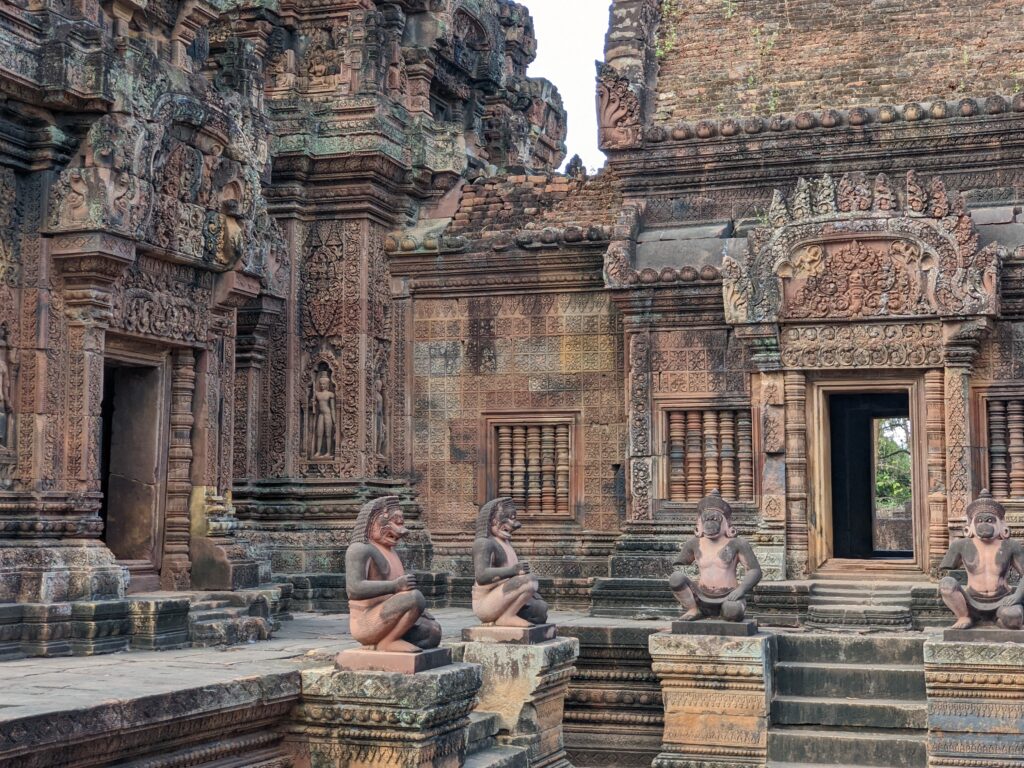
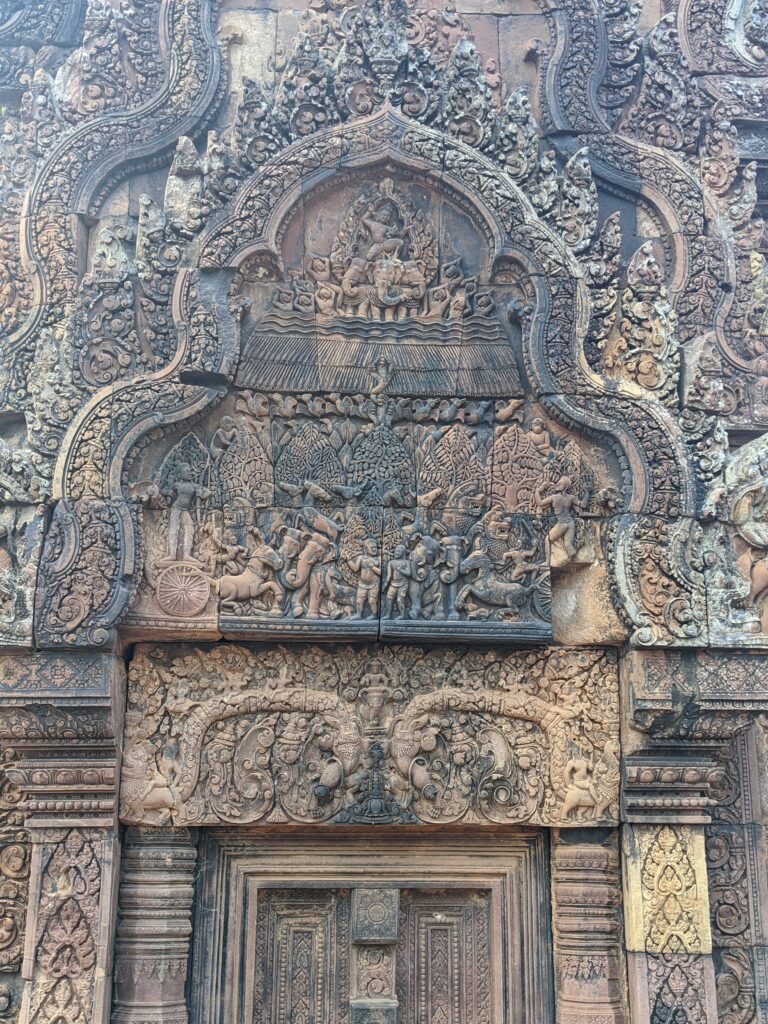
Our plan had been to leave Banteay Srei in enough time to make it to Phnom Krom before sunset. It was going to be a good hour and a half in the tuk tuk! We were making good time at first but ran into some traffic so Mr. Ros, our tuk tuk driver, began to haul ass to get us to the hilltop in time. It was during this ride that I realized I was starting to become desensitized to the Cambodian road culture. I wasn’t anxious at all.
Phnom Krom is a 140 meter tall hill with an active temple at the top. It is famous for the view over the rice fields at sunset. It was an incredibly steep climb up to the top and we were out of breath almost instantly. As we made our way up, there were children following us begging us for food. They were chanting “Yum! Yum!” and touching their fingers to their mouths repeatedly. One of the boys actually hit Bradley’s arm when he told him we did not have anything to give. It made me feel sick in my stomach. Giving in to children that beg is something Cambodia frowns upon and is a pretty big issue there. The people are trying to teach children that it is not a lifestyle that will not be supported and it is a lifestyle that ultimately keeps them living on the streets. I wondered where their parents were. We made it to the top just in time for the sun to set. It was stunning and it was totally worth it. I laughed at myself and reluctantly apologized to Brad for complaining about how tired my legs were and how sweaty I was on the way up! We took our time on the descent and watched the warm light slowly fade away from the rice fields as the darkness took over.
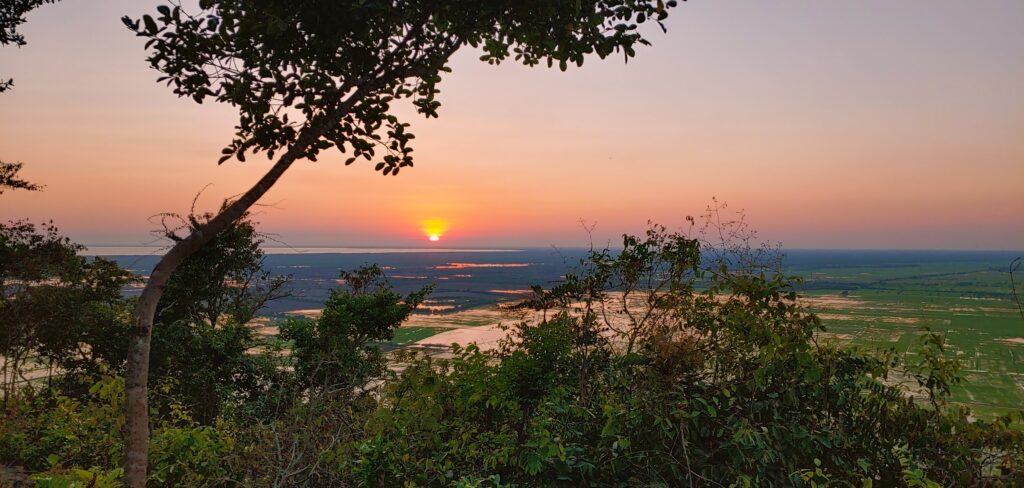
Exploring the ancient ruins of Cambodia was by far one of the most magical, illuminating, and resonating experiences of my life. This is a part of the world everyone should visit and learn about. I’m incredibly thankful that I got to experience these extraordinary places the way that I did with the greatest travel guide of all time.
For more photos of Angkor Archaeological site, you can visit my Facebook Album of Cambodia.
